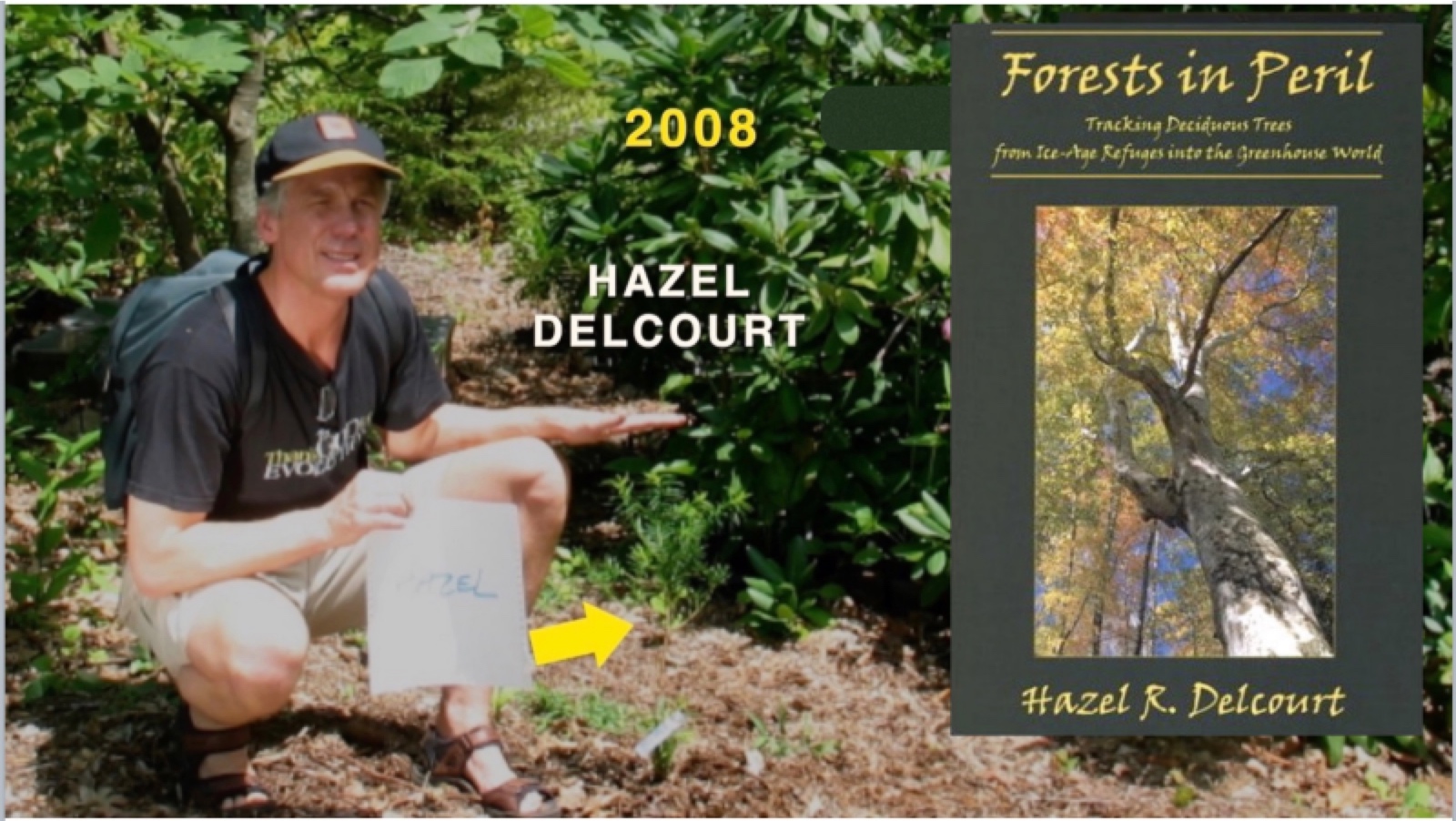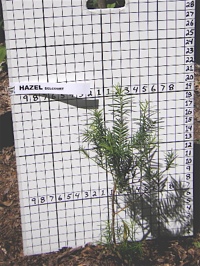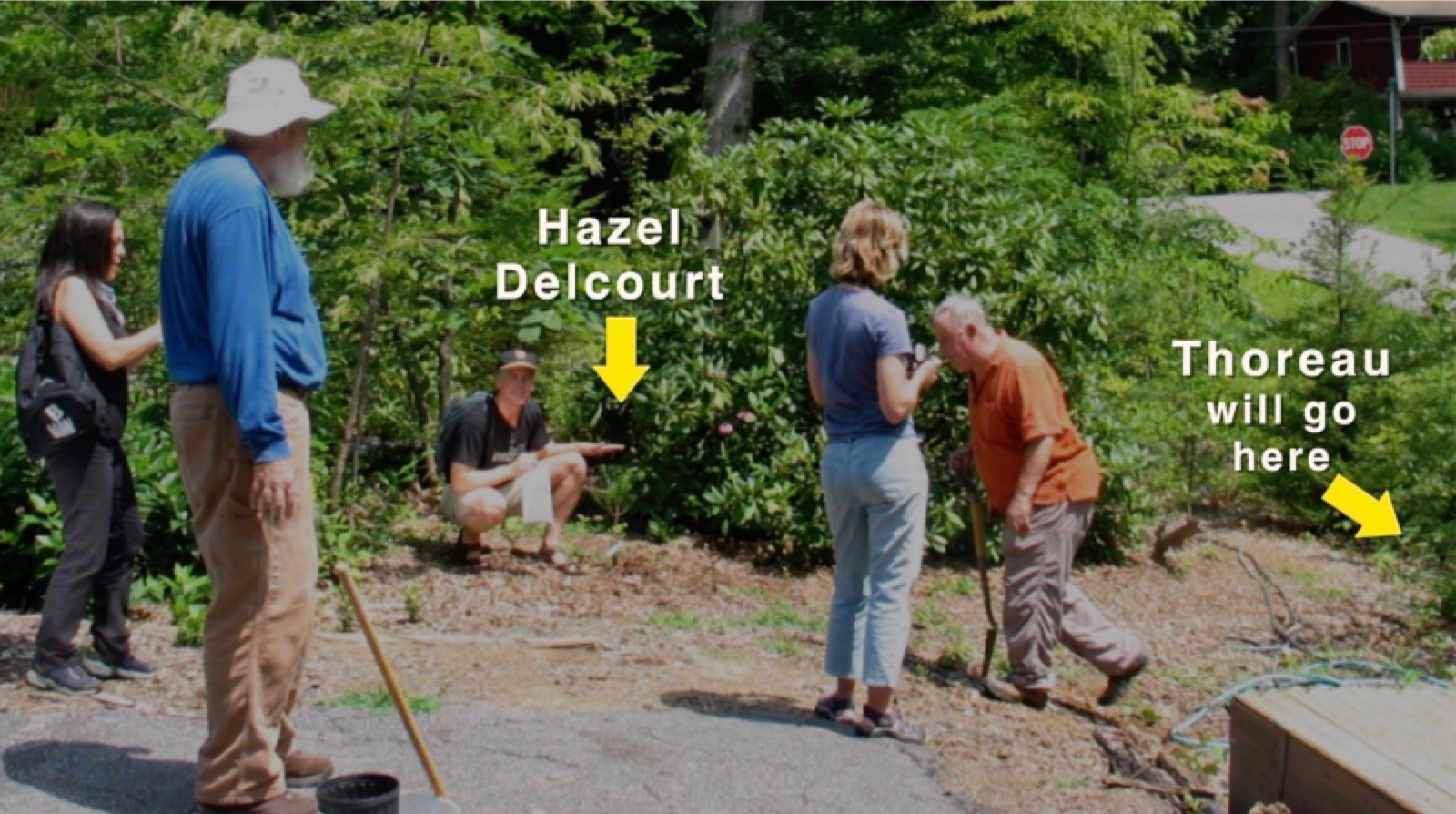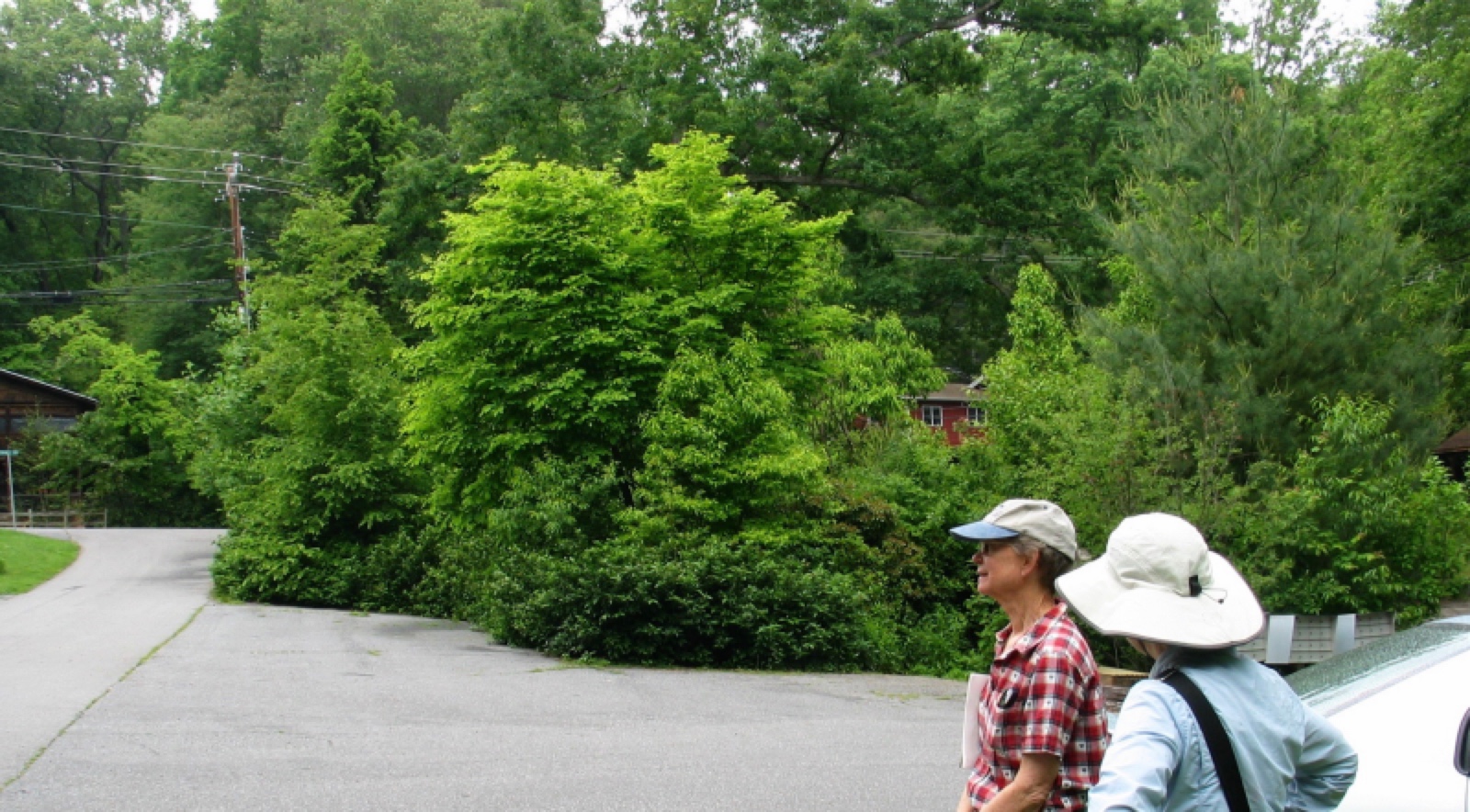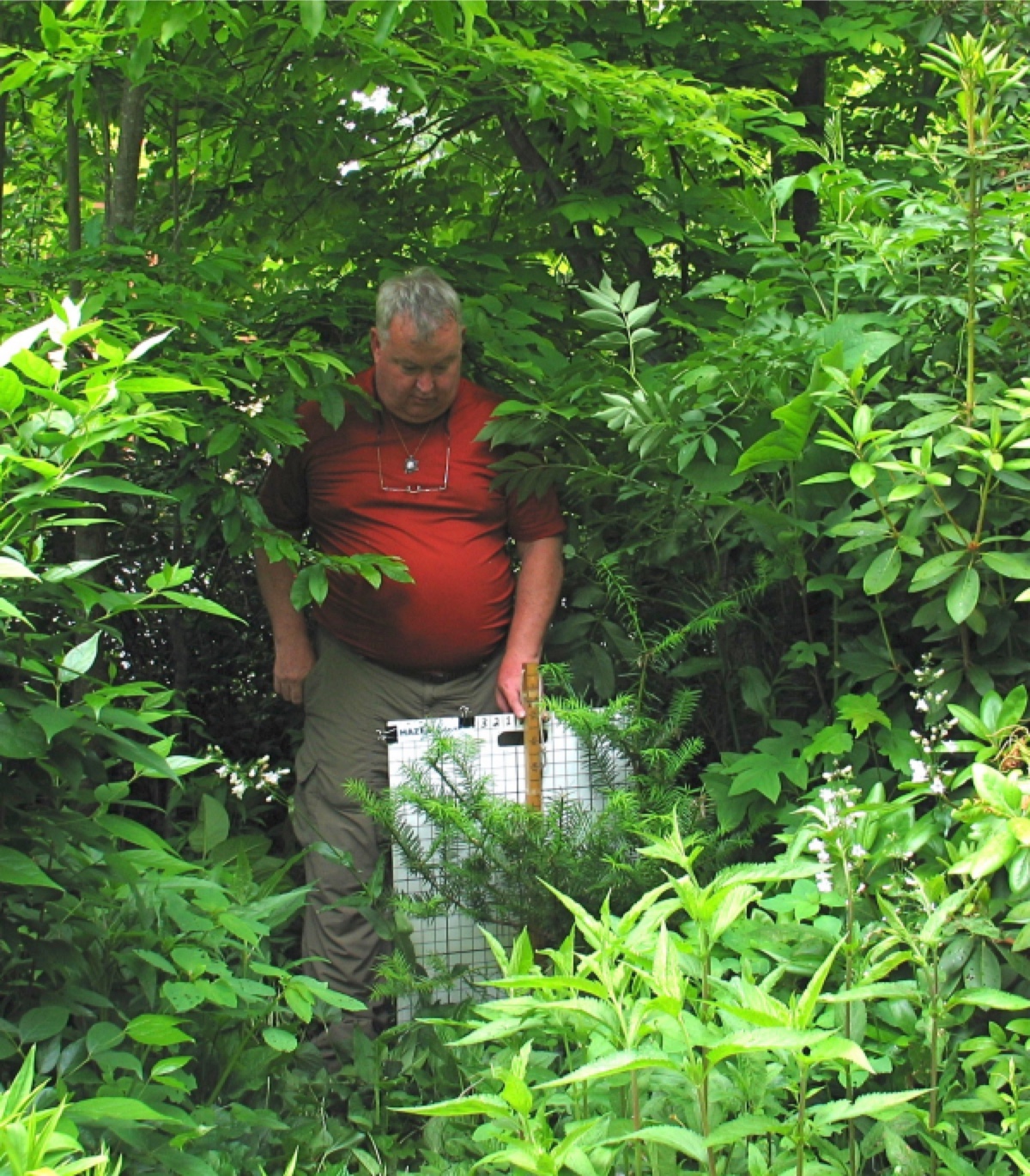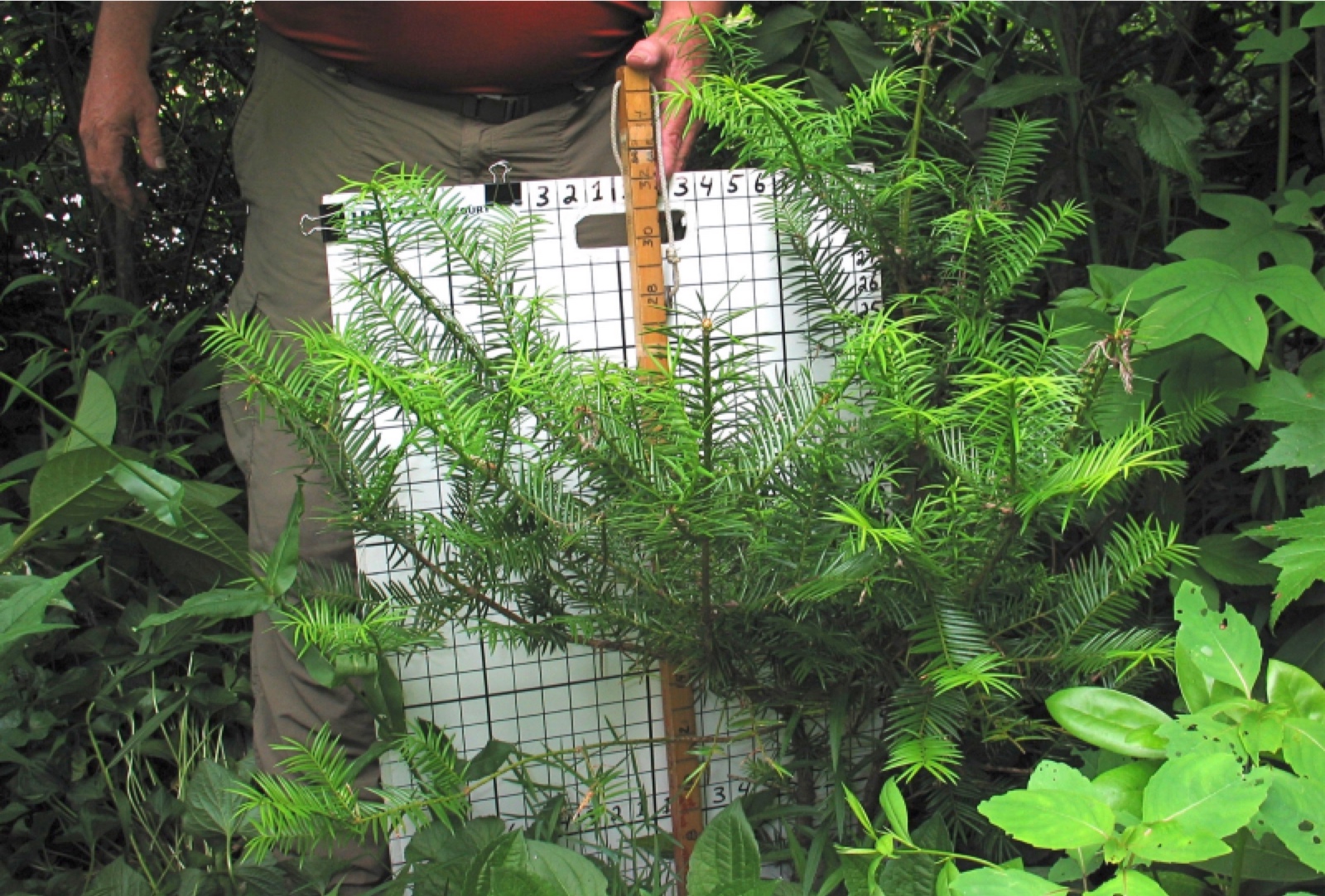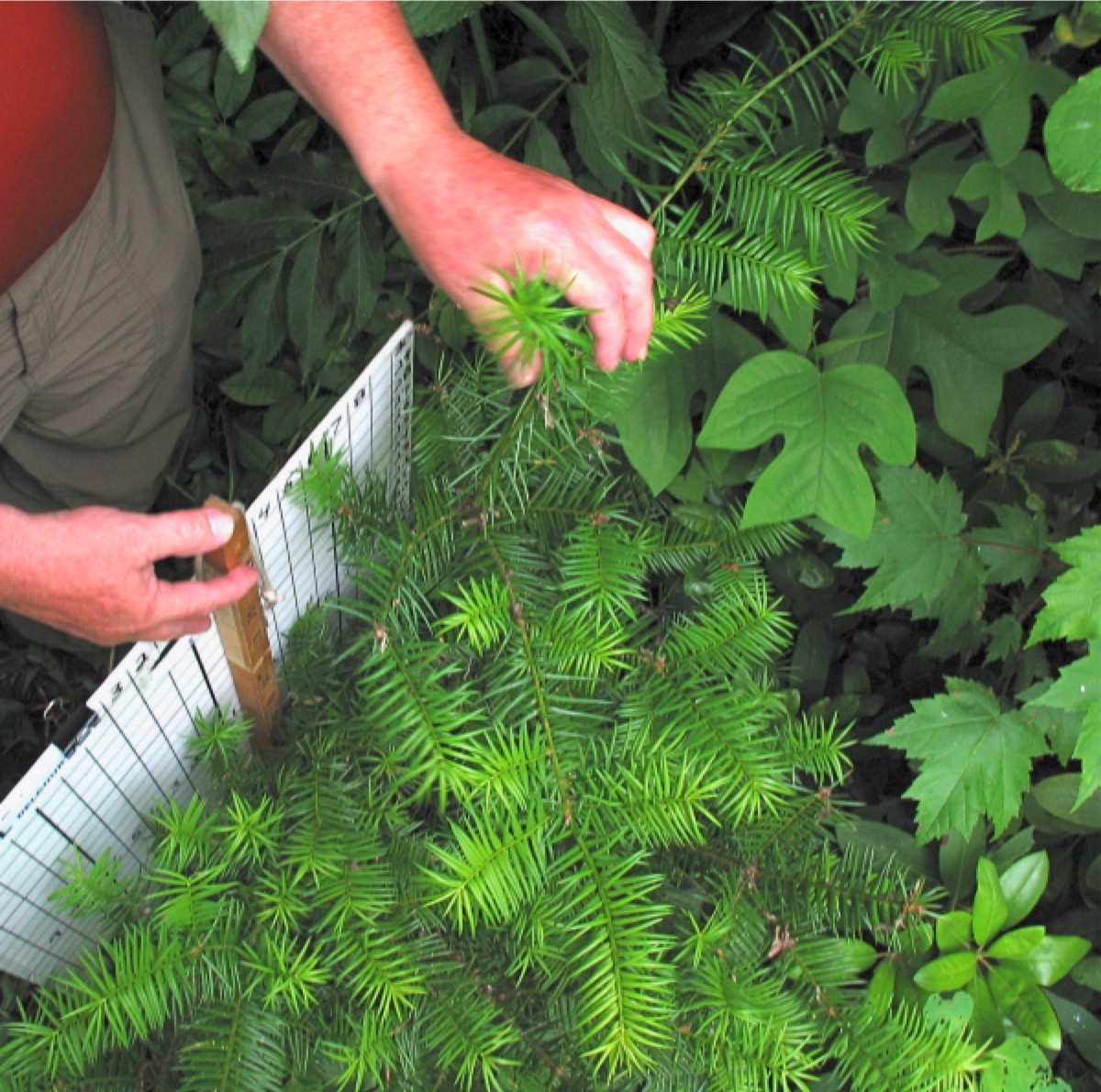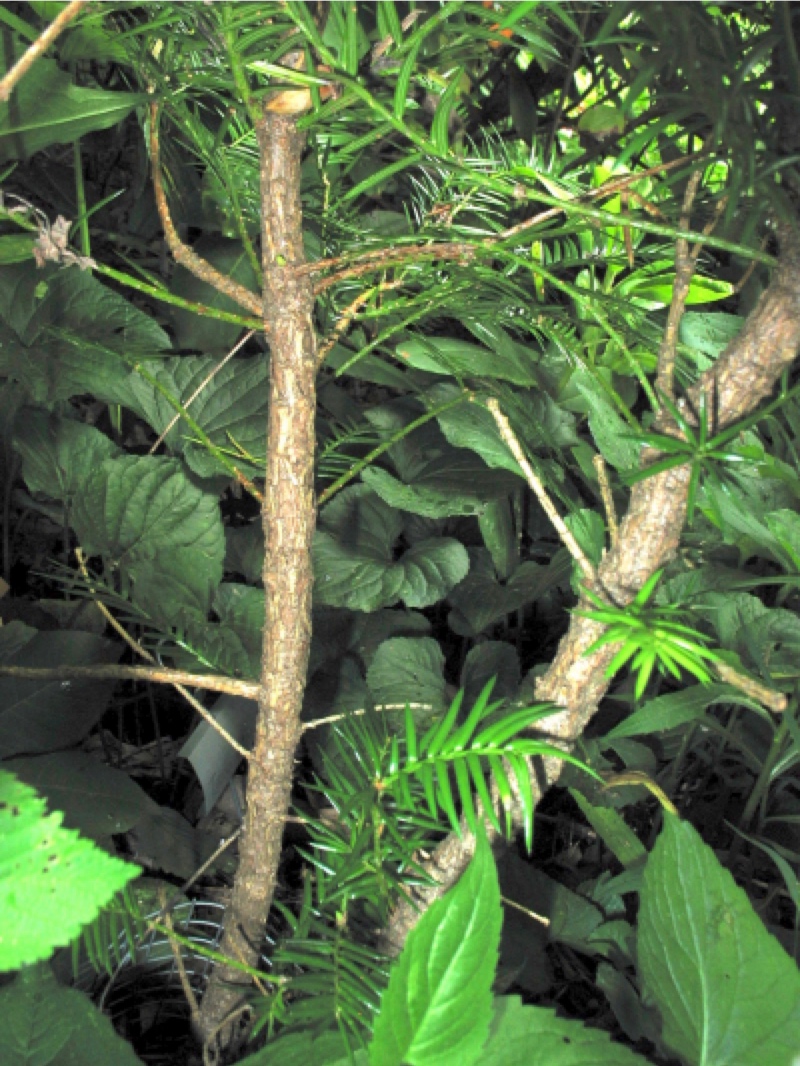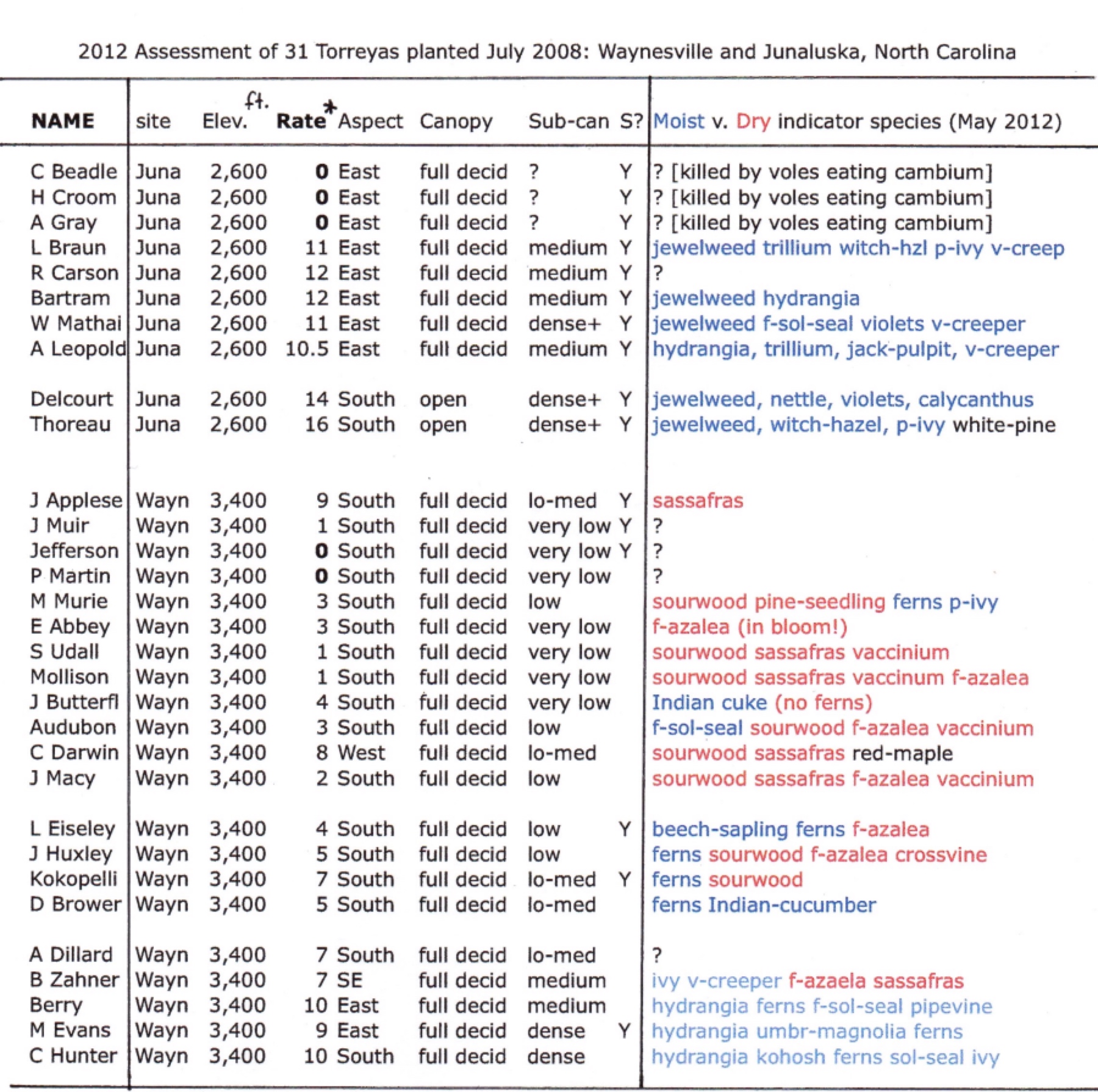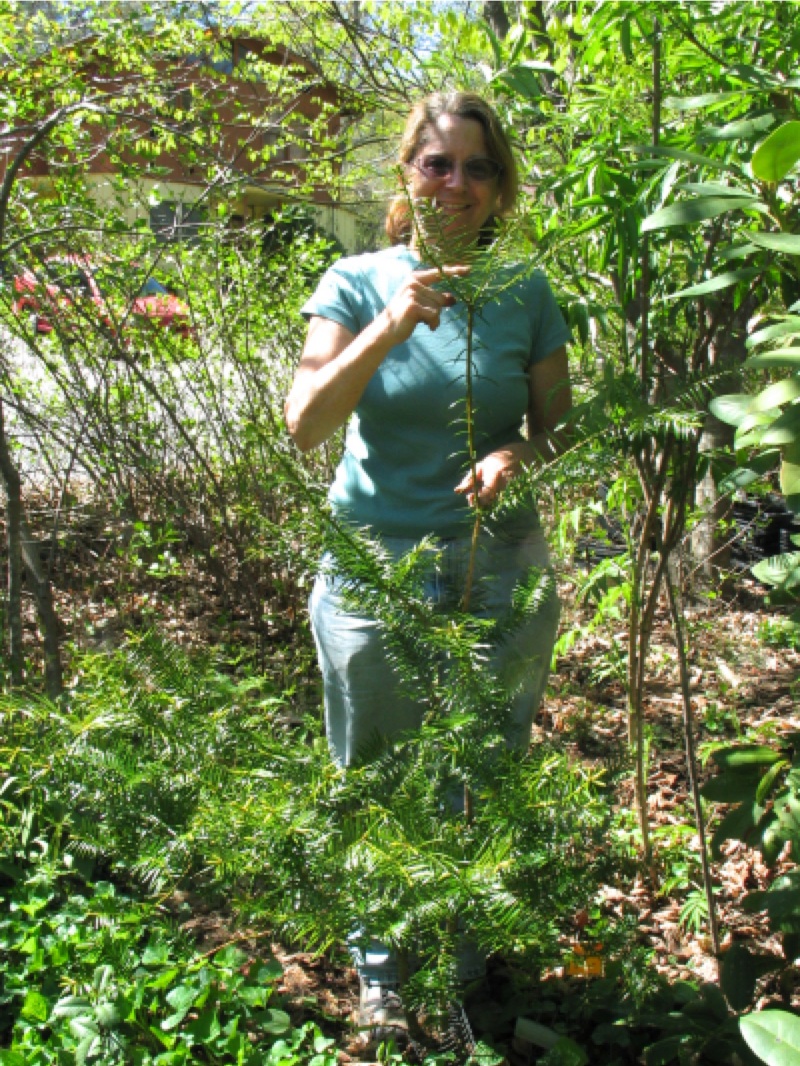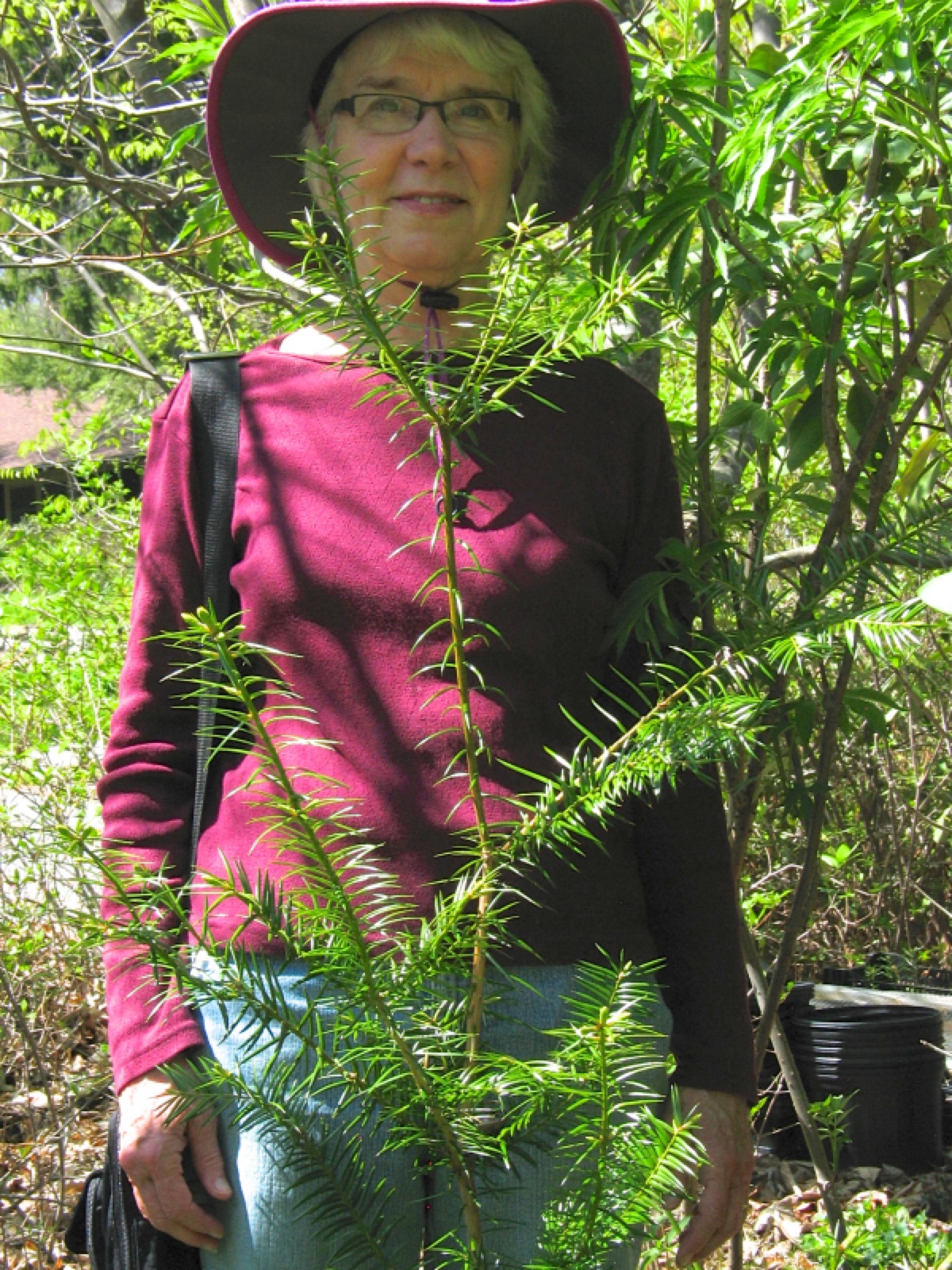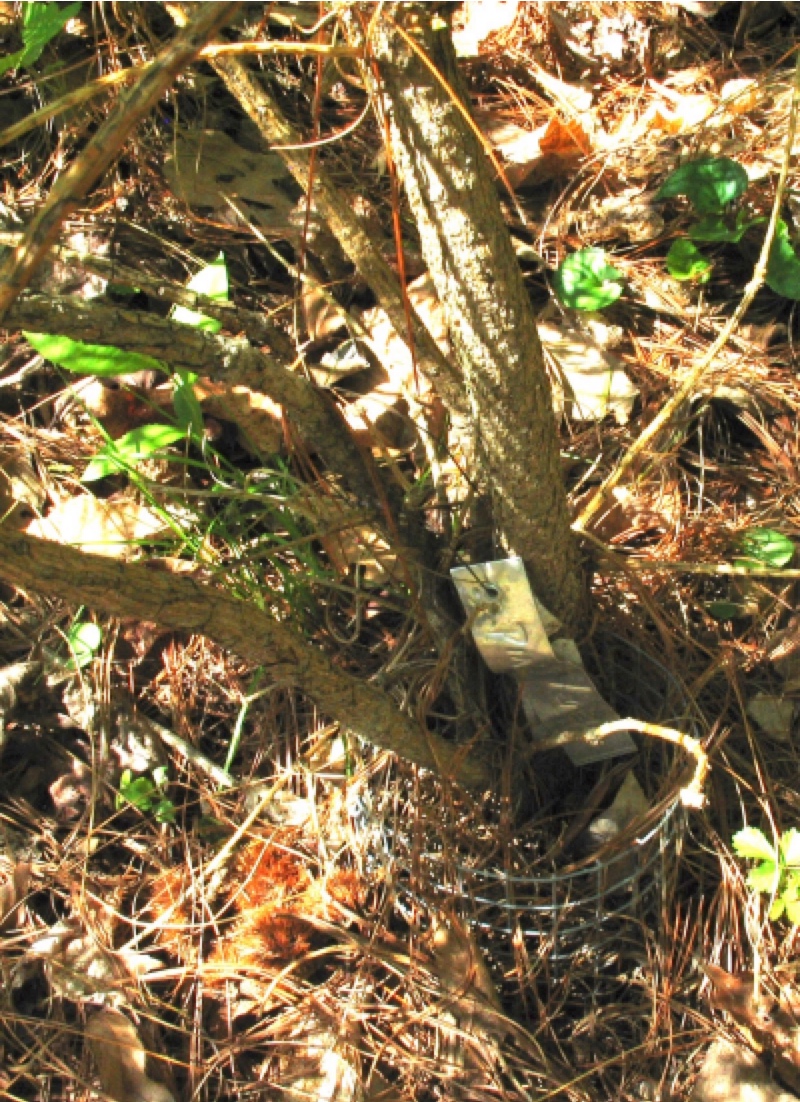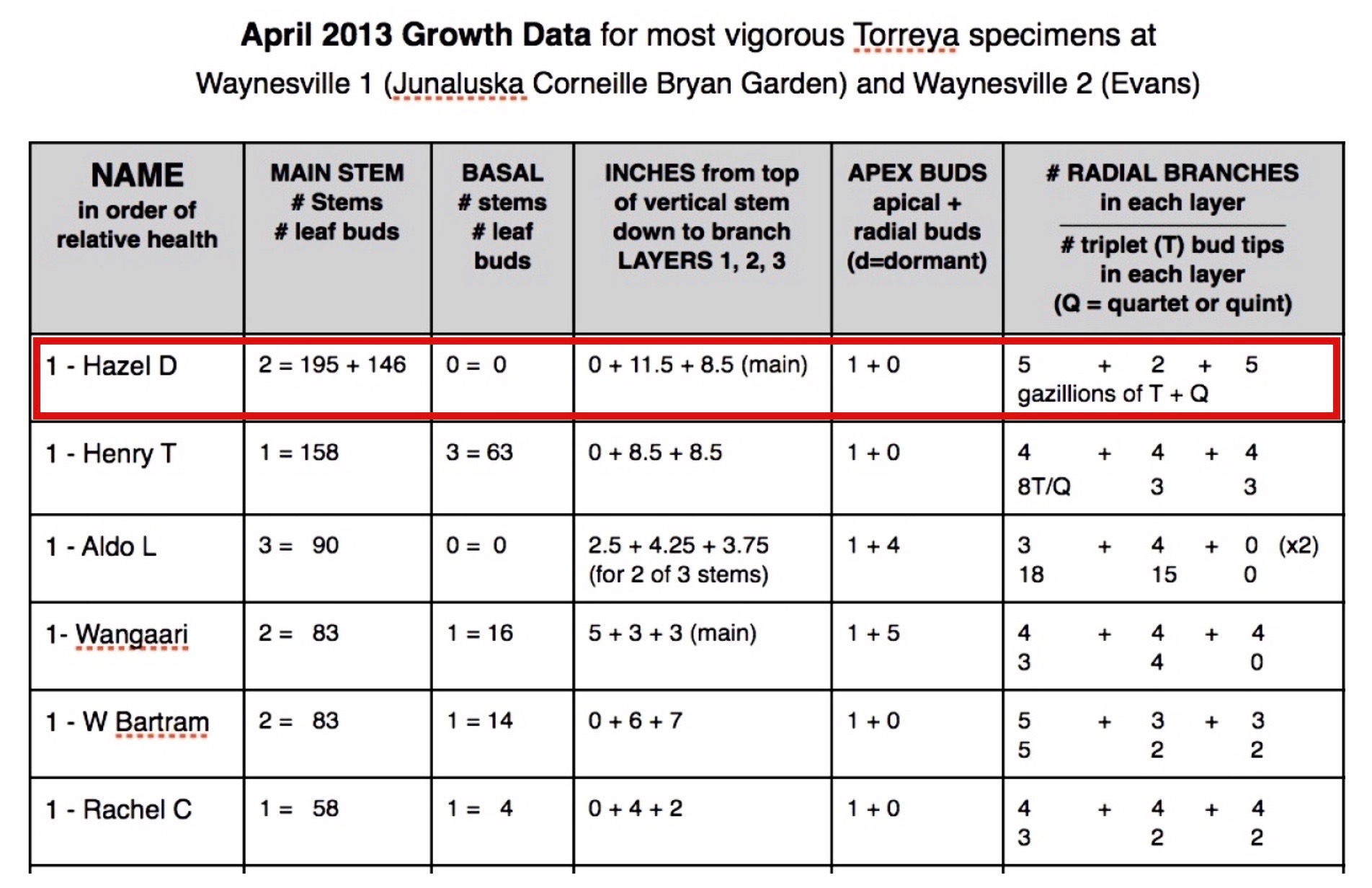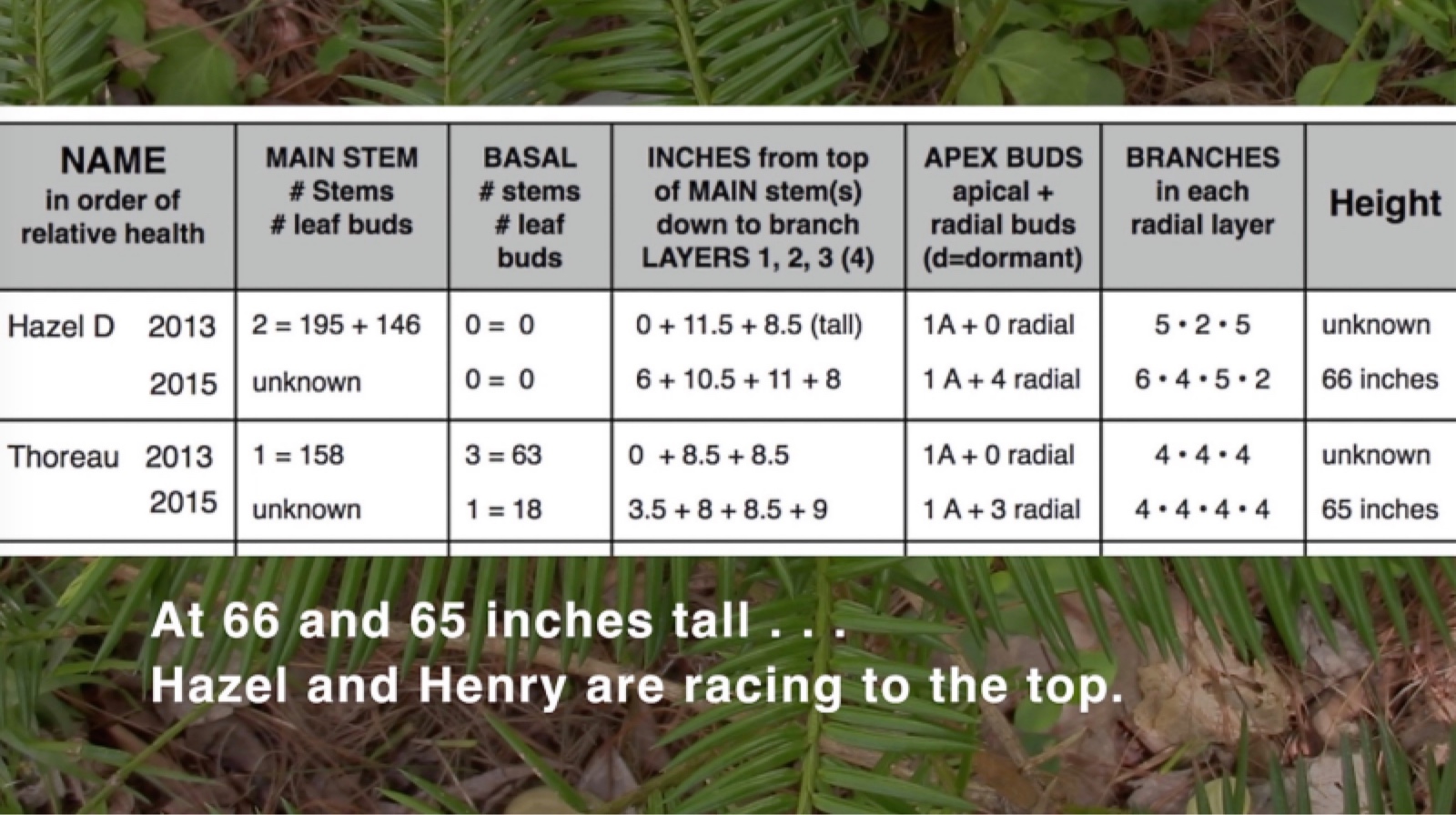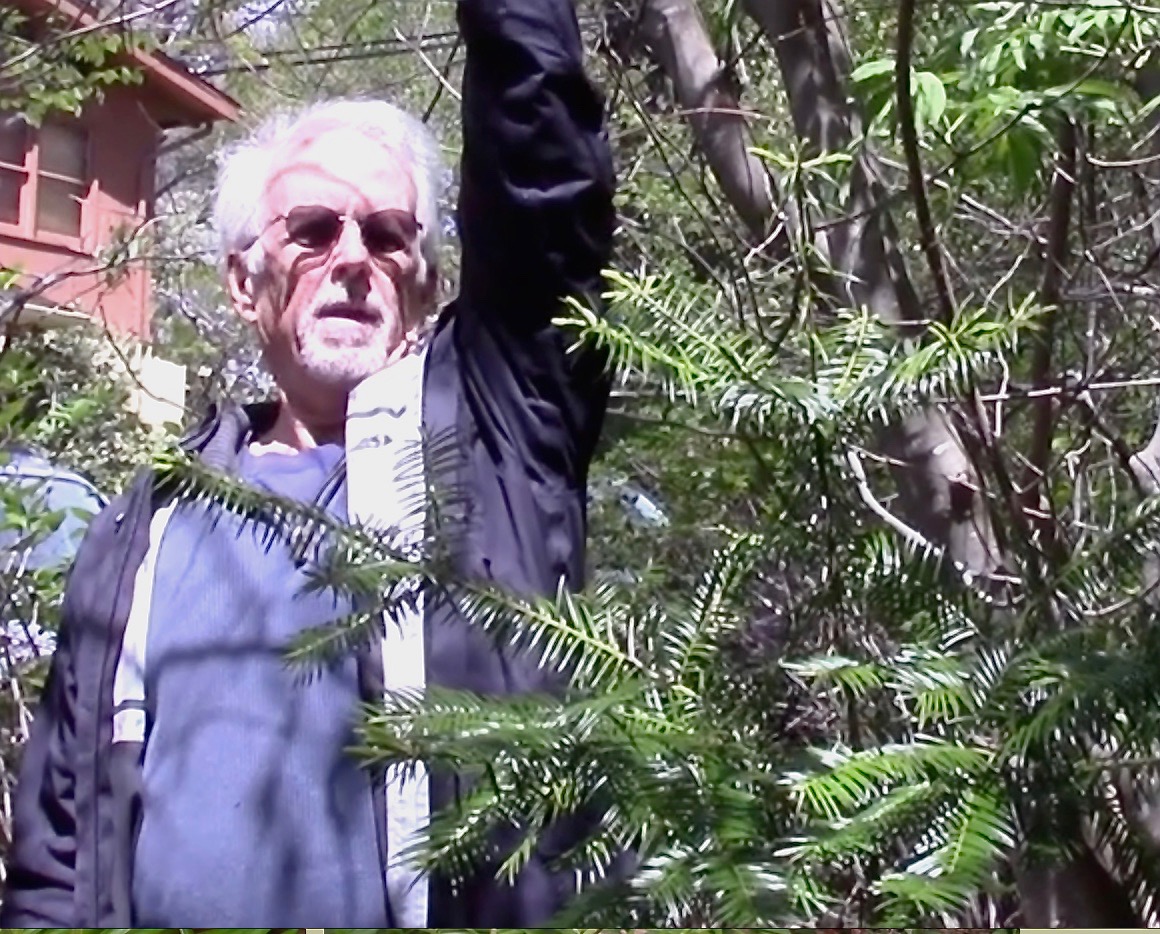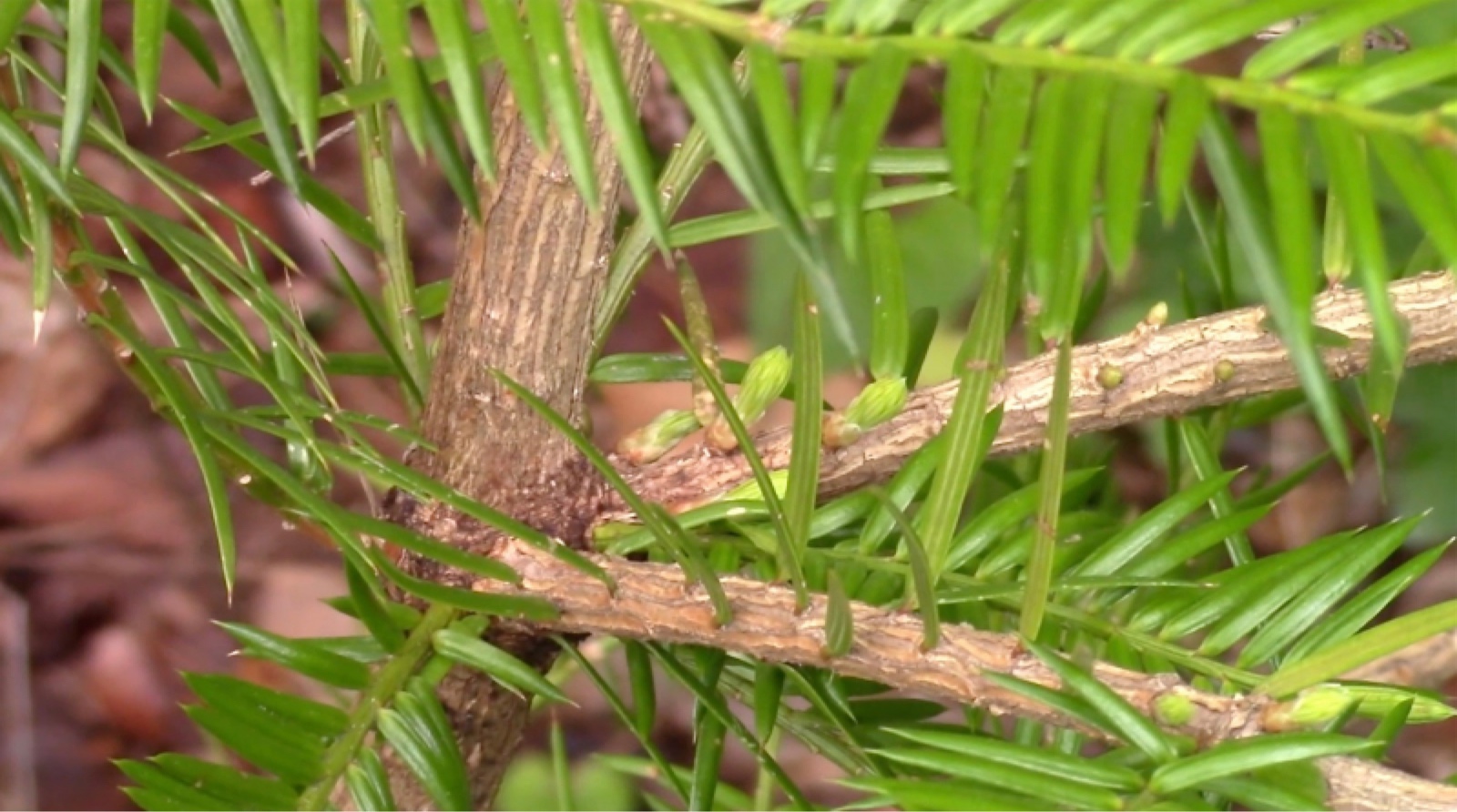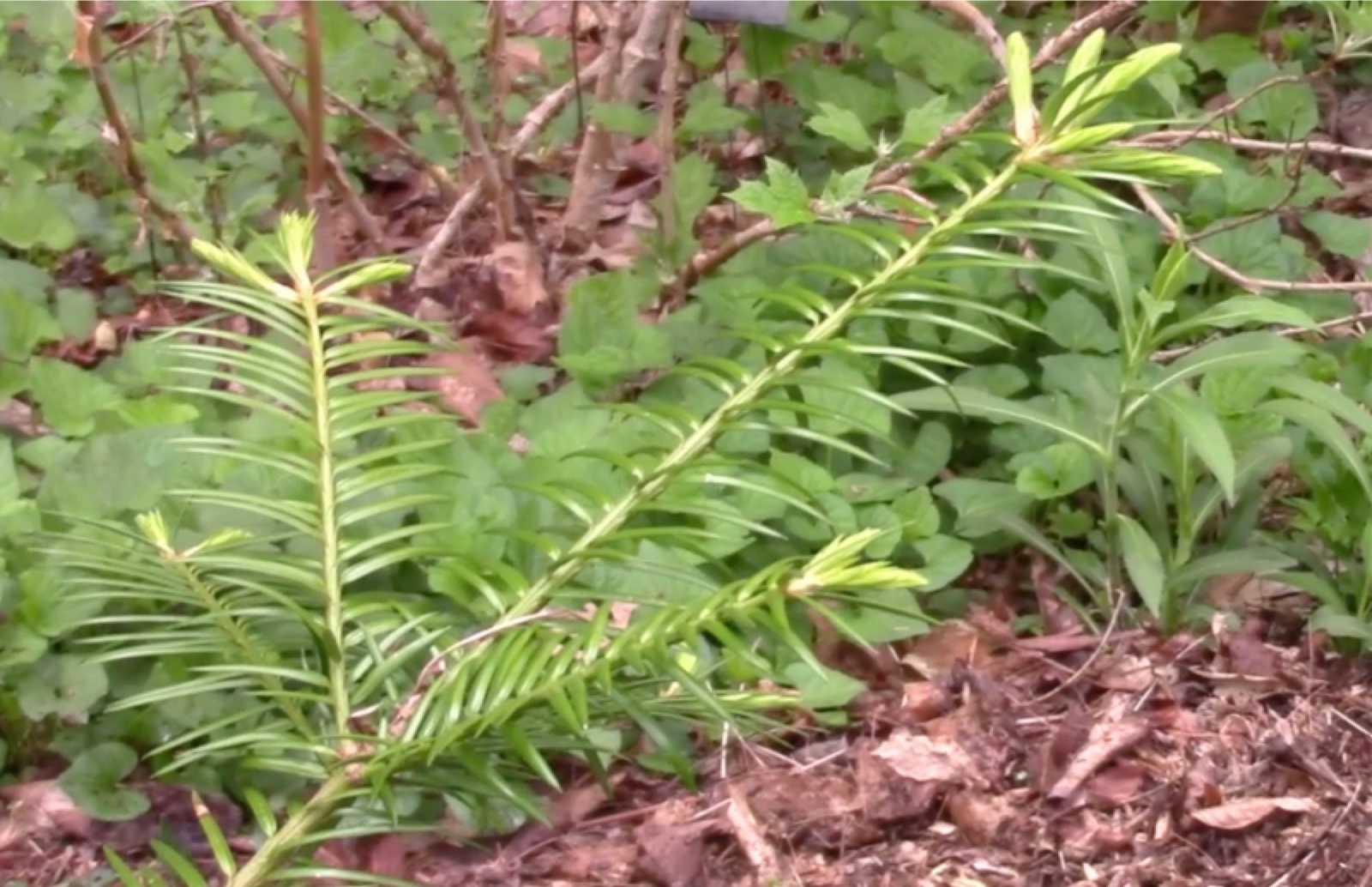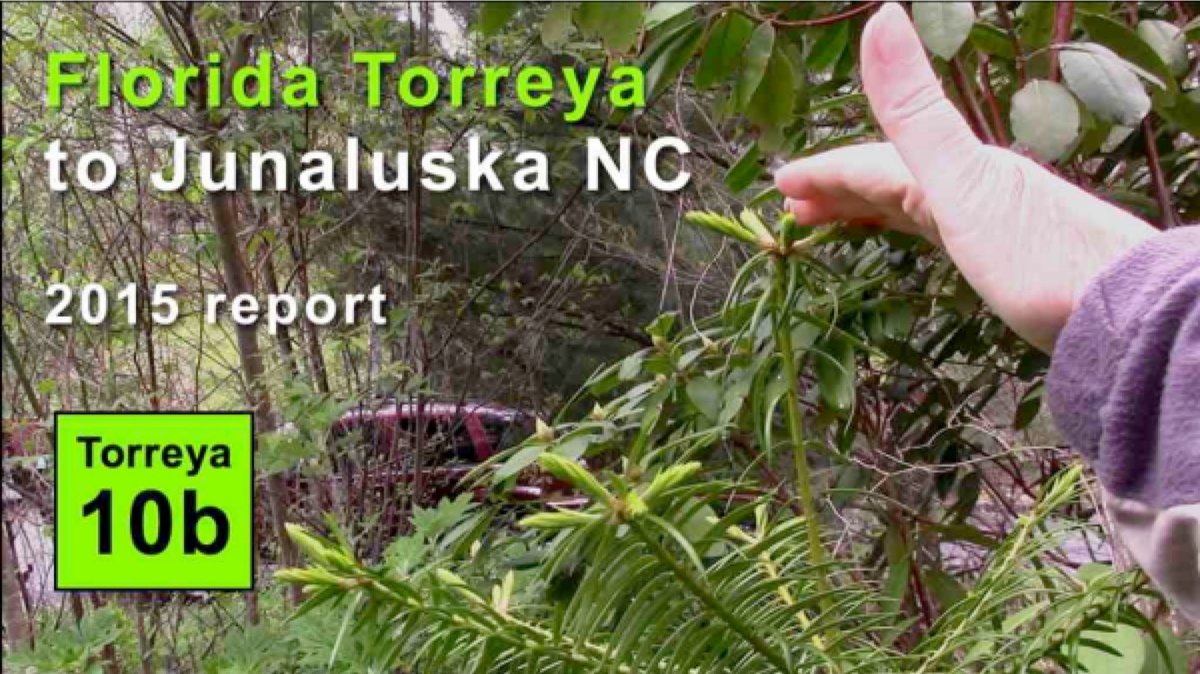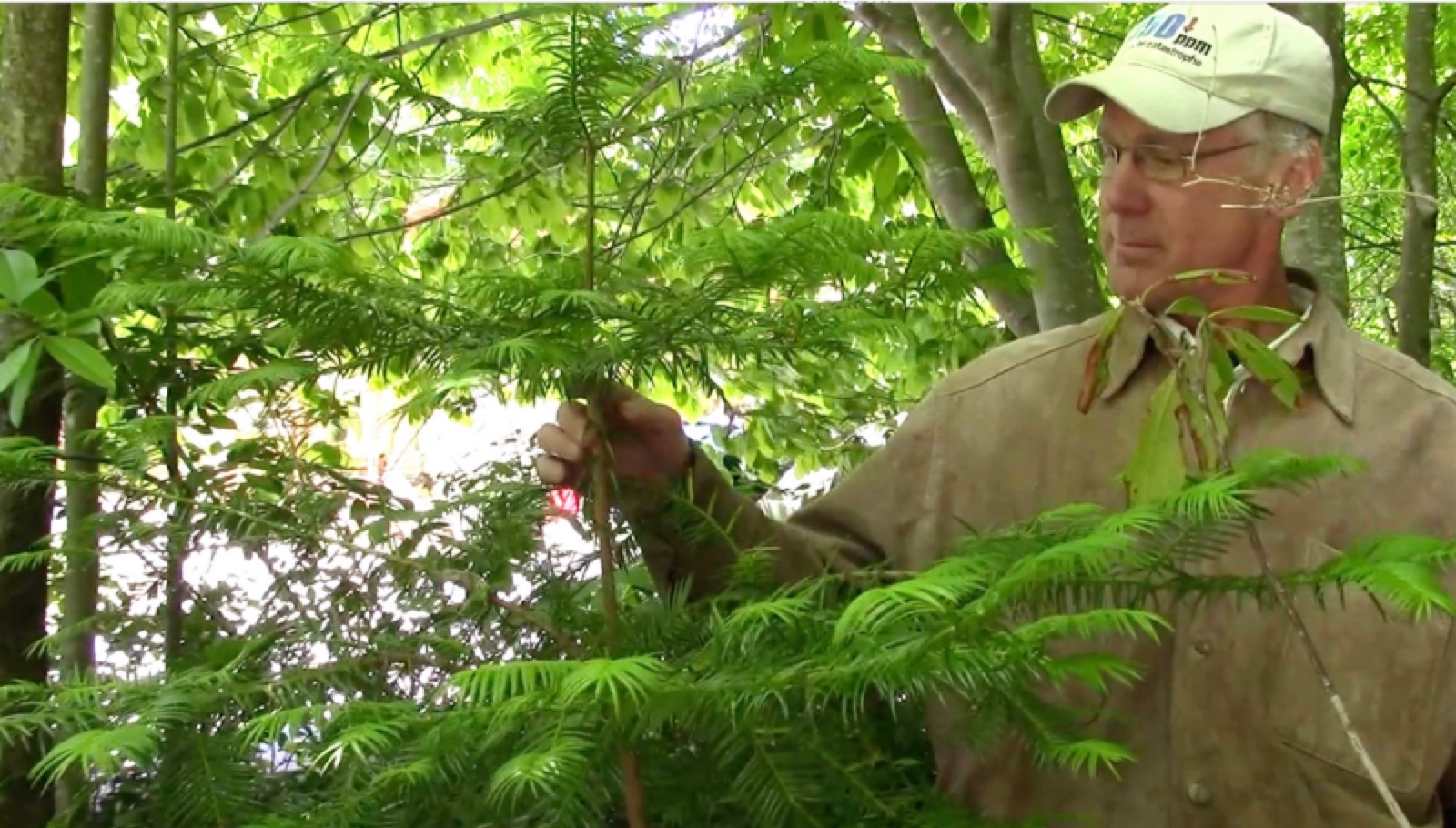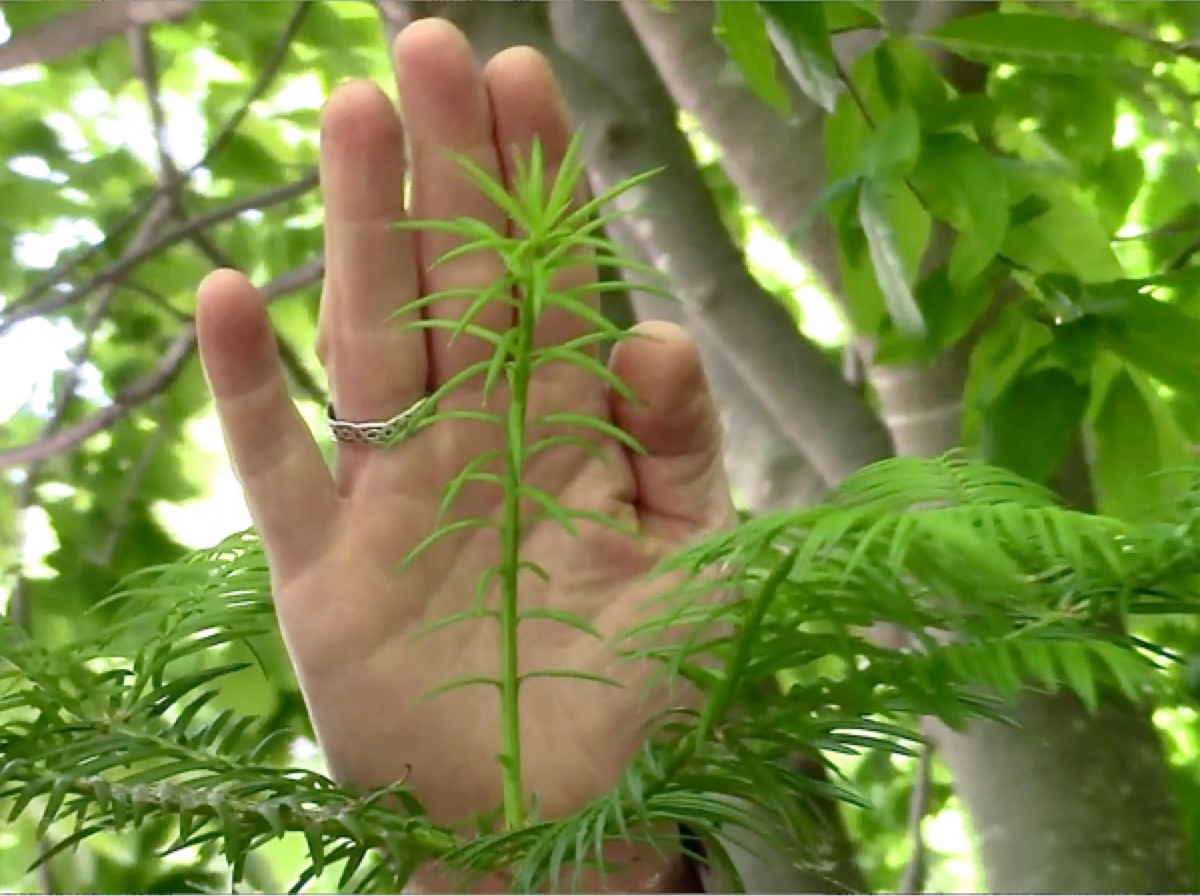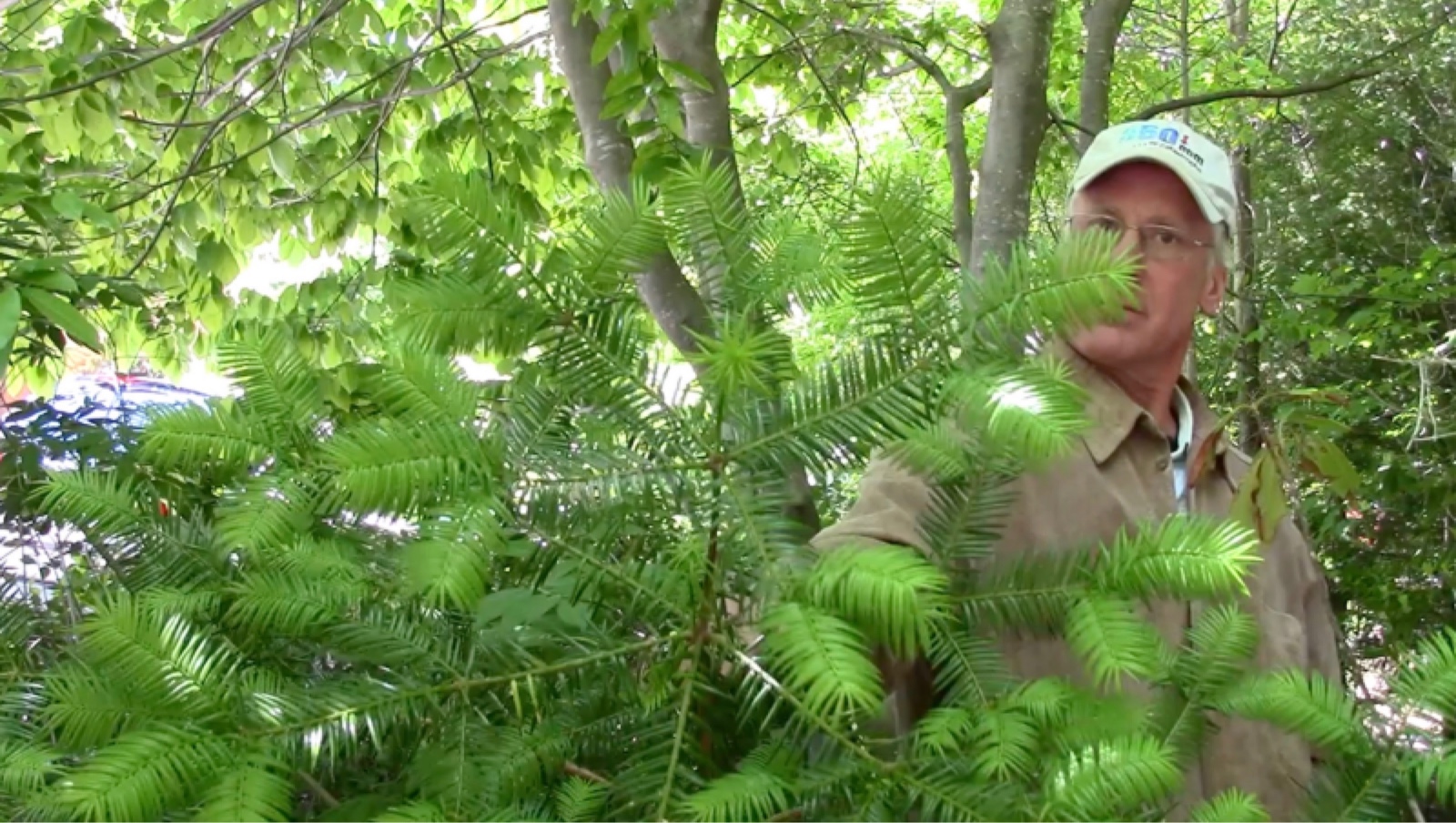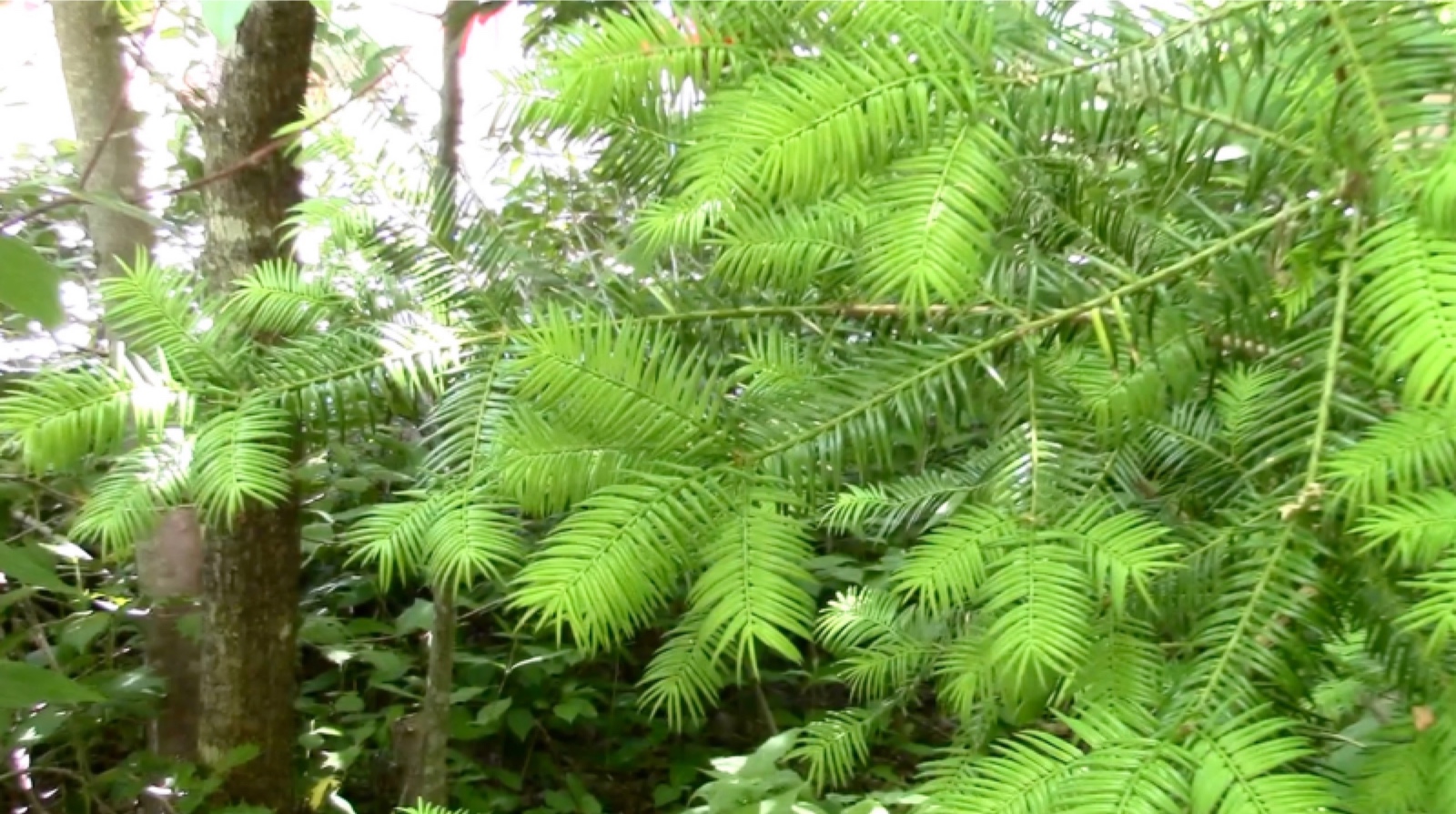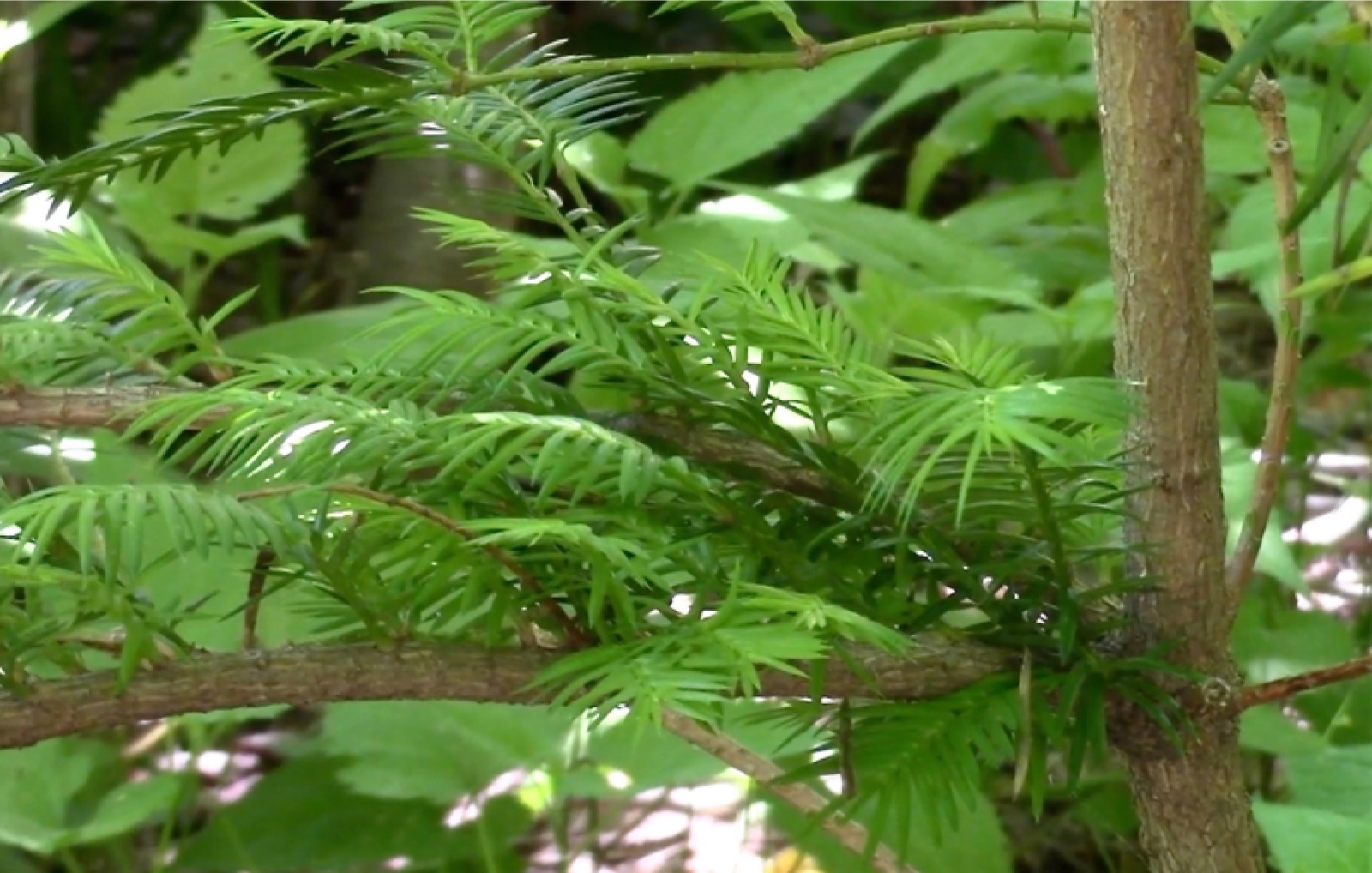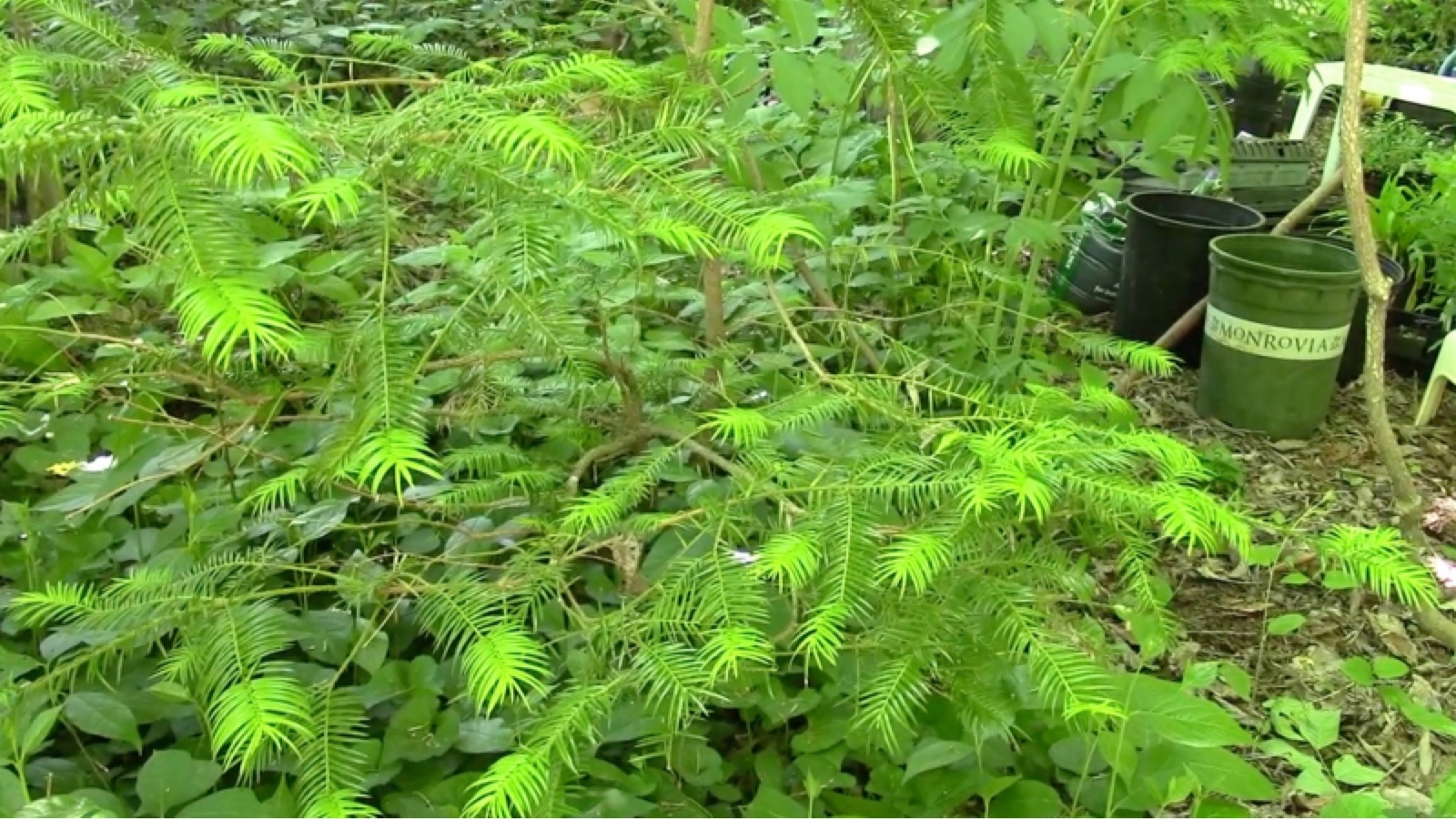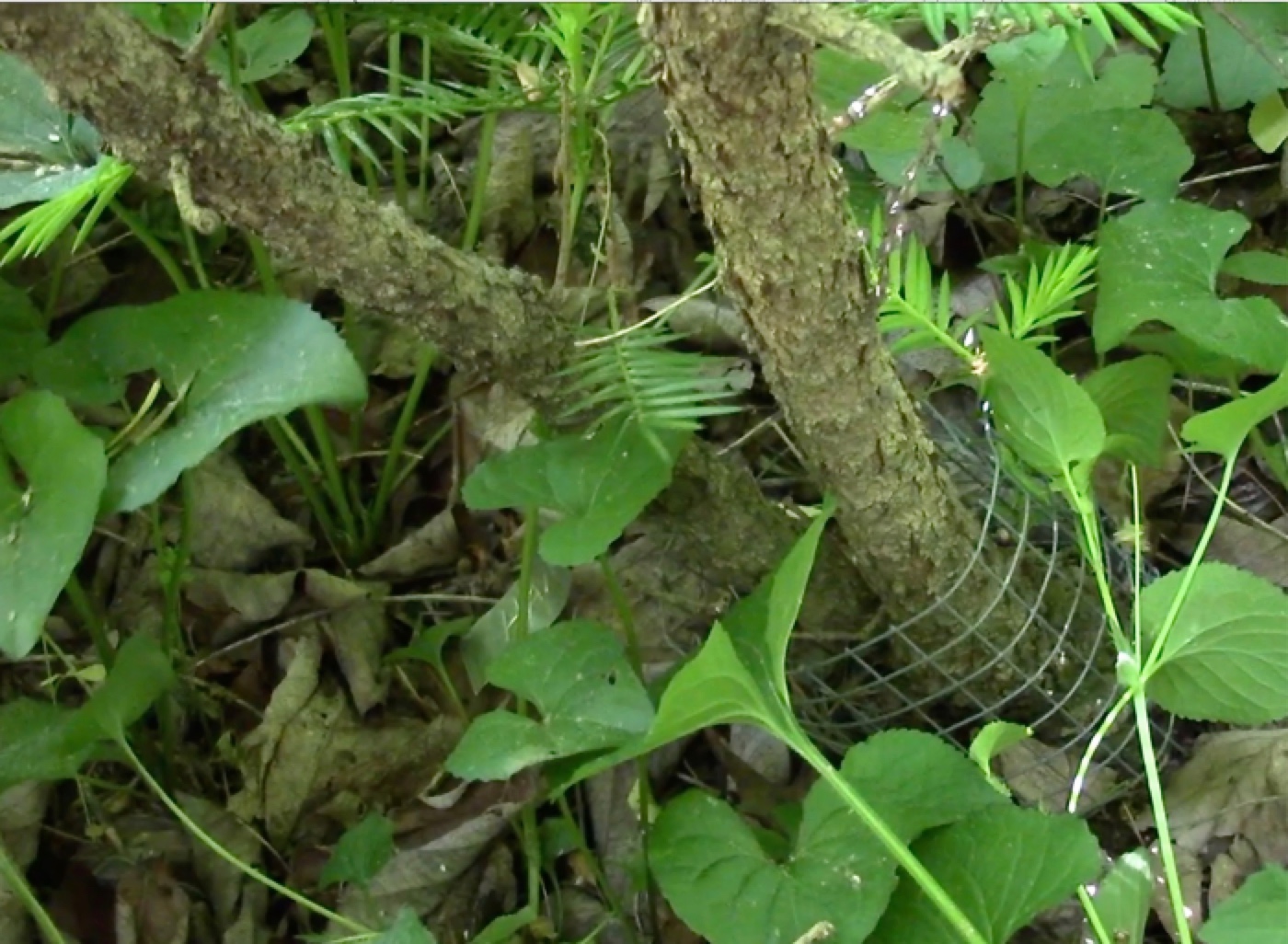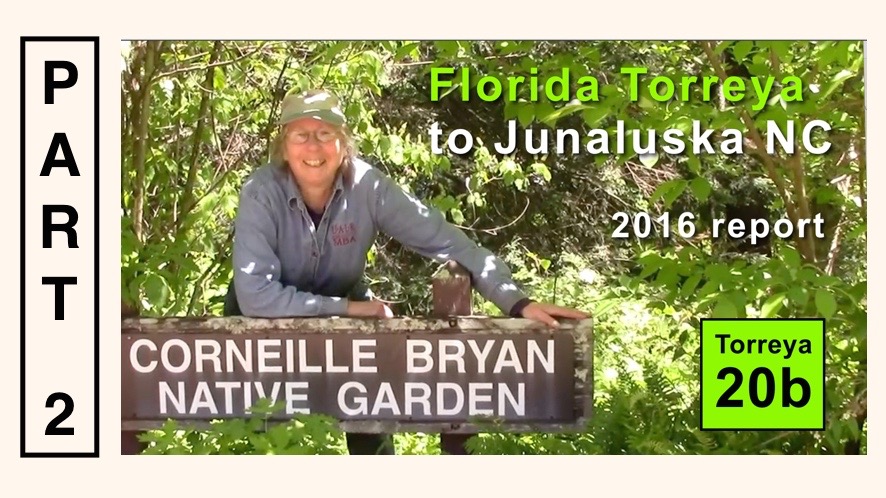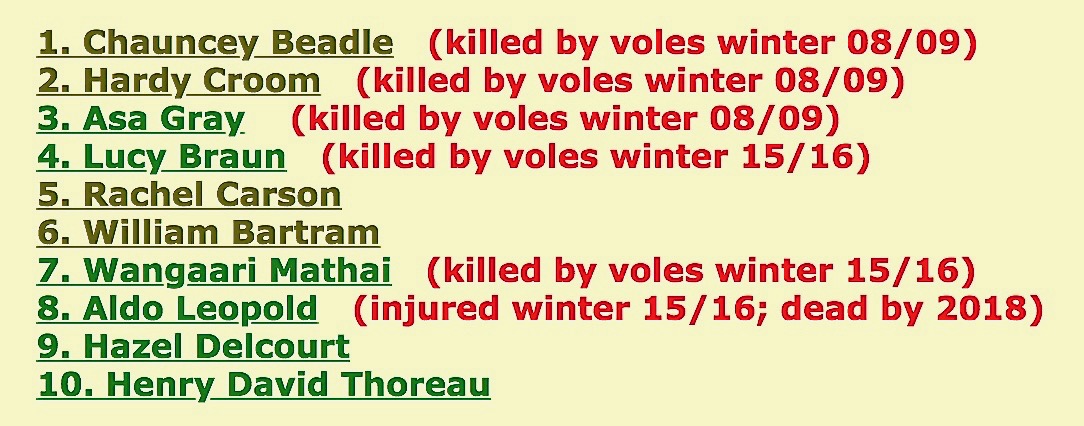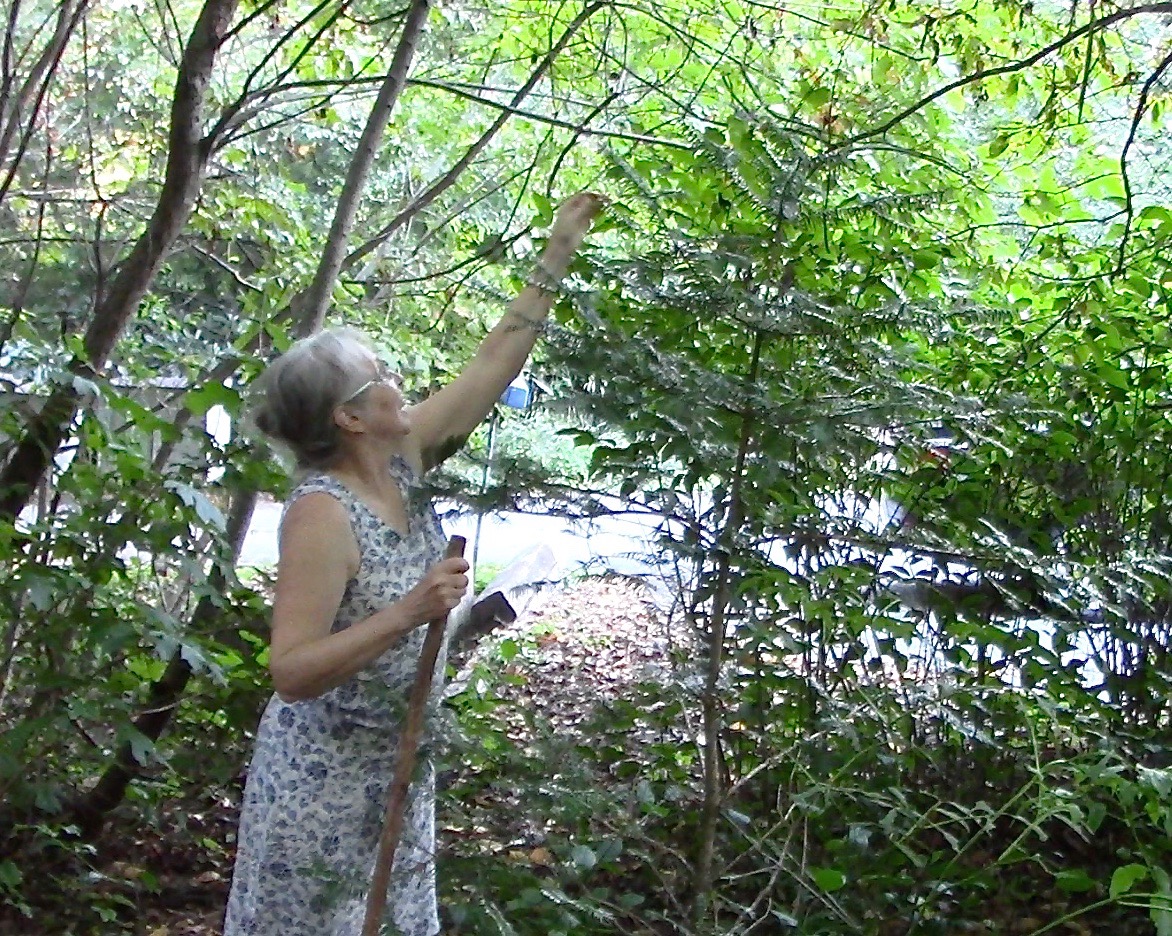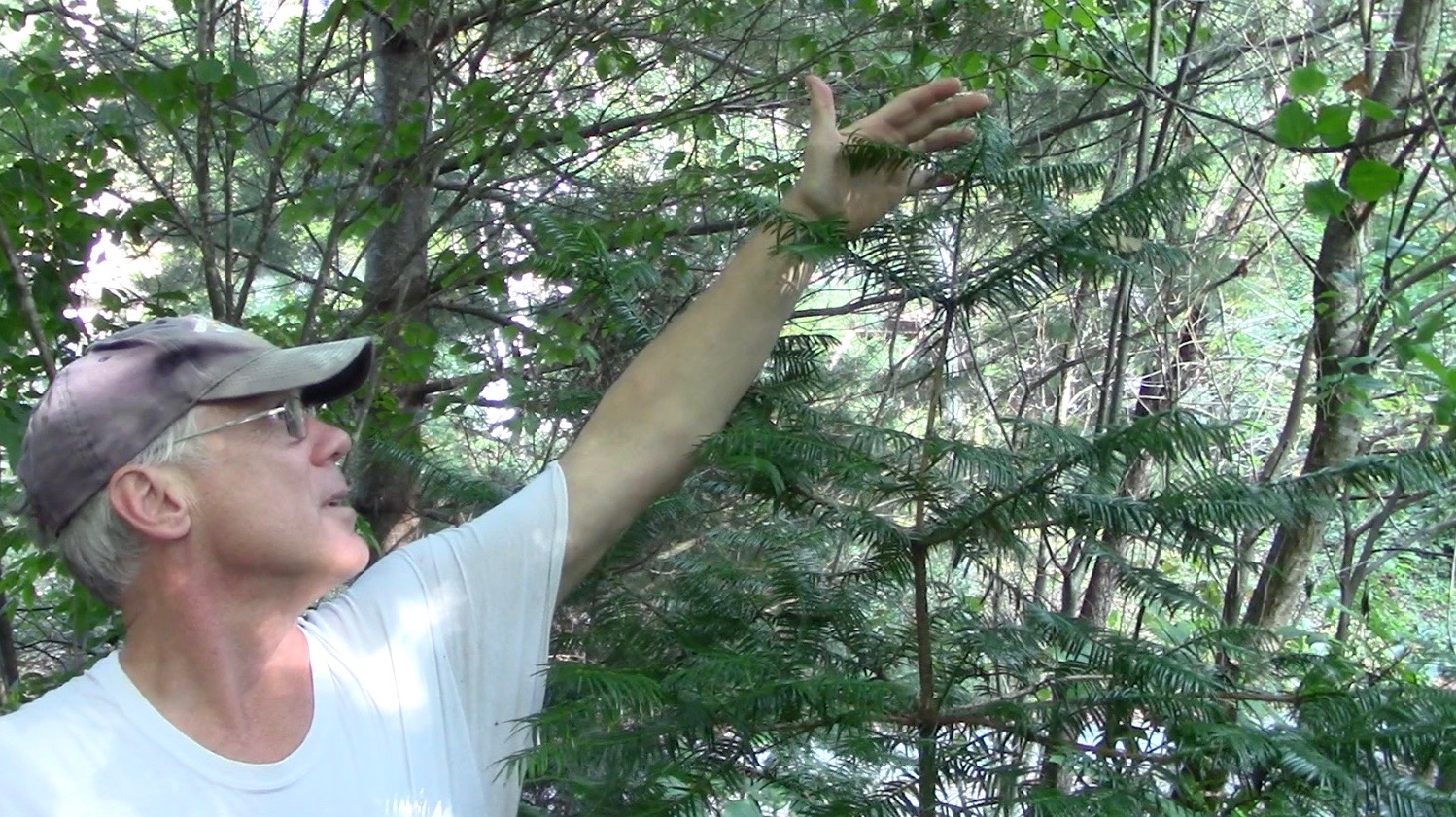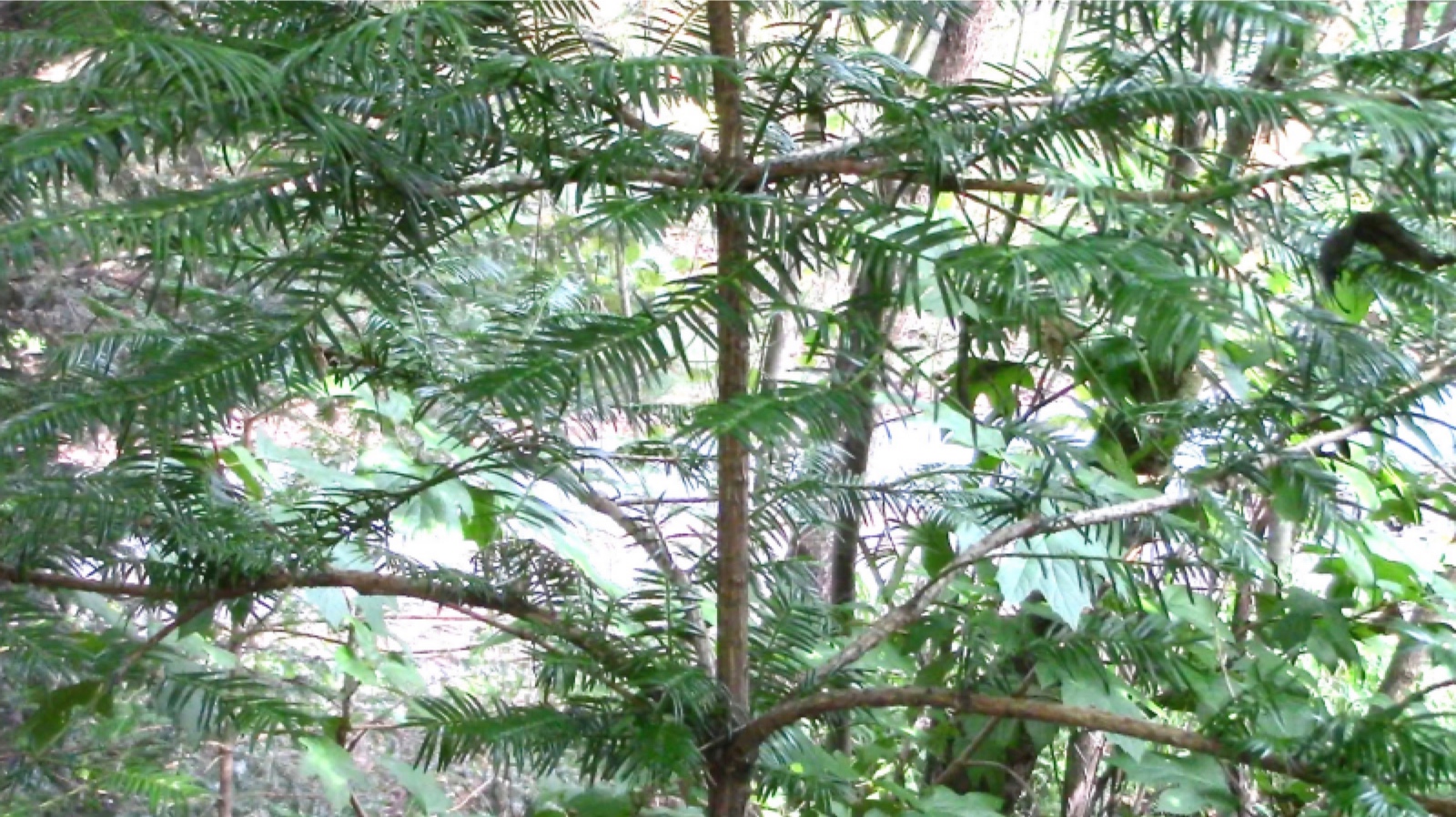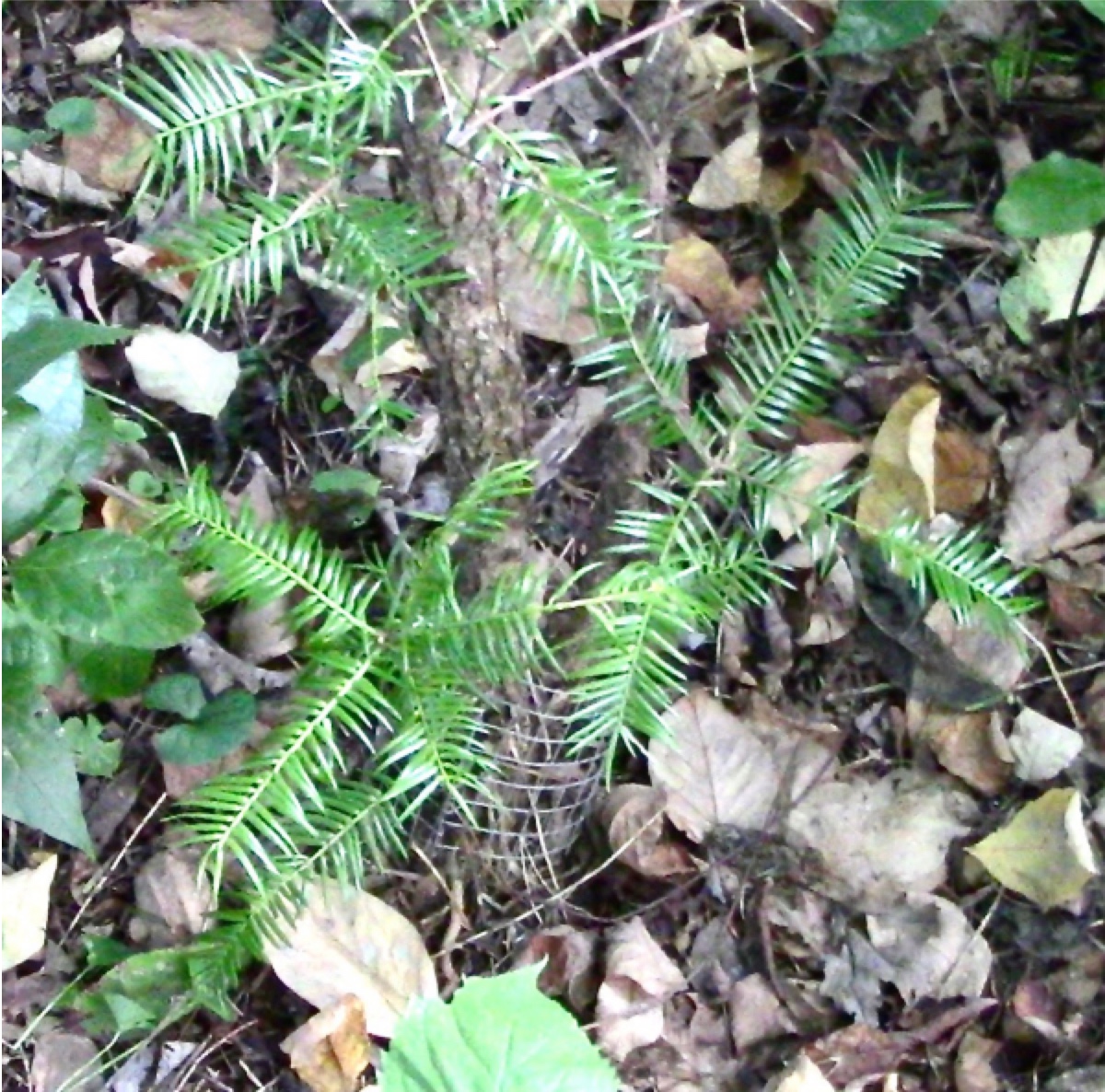|
Lake Junaluska, North Carolina (planted July 2008)
CORNEILLE BRYAN NATIVE GARDEN, Lake Junaluska. NE-facing slope of a NW-to-SE ravine with perennial creek at the bottom (2,600 feet elevation). The uppermost canopy is almost entirely deciduous, thus affording a lot of sun for evergreen growth in early spring, late fall, and mild winters.
Connie Barlow chose the name HAZEL DELCOURT for this tree because it was Delcourt's 2002 book (followed by a meeting in her office at University of Tennessee) that led Connie to initiate the Torreya Guardians effort. Access Connie's book review of Forests in Peril: Tracking Deciduous Trees from Ice-Age Refuges into the Greenhouse World (published in the Winter 2004/2005 issue of Wild Earth). See also the book review that Connie posted on Amazon in 2010, owing to her disappointment in the 2010 Recovery Plan Update, which expressly dismissed the proposal to conduct an assisted migration pilot project.
Michael Dowd has his hand marking the top of this just-planted seedling. Both HAZEL DELCOURT and HENRY DAVID THOREAU were planted in July 2008 along an isolated northern chunk of the garden (photo below), surrounded by pavement. This is an unmarked part of Corneille Bryan Garden, used mostly for storage of tools, pots, and hoses and sometimes seedling starts. The view in the photo below shows the plantings are full-sun facing south.
Advance to TENTH ANNIVERSARY 2018 LEARNINGS here.
18 MAY 2012
ABOVE LEFT (May 18, 2012): Both "Hazel Delcourt" and "Henry David Thoreau" specimens are now immersed in a jungle of deciduous herbs and shrubs. Both are about a dozen feet inward of the pavement. The greenery has, in just four years, covered all the open brown soil visible in the 2008 photos above. The White Pine is shooting skyward, blocking the east. ABOVE RIGHT (May 18, 2012): Lee Barnes uses the same grid he created in 2008 to easily show height and growth pattern of each of the 10 potted seedlings planted at Lake Junaluska and the 21 at the Waynesville site nearby. Lee is facing south (toward the pavement), so this evergreen conifer would still get good sunlight for growth in late fall and early spring, despite the immense amount of herbaceous growth surrounding it. Some of the surrounding deciduous plants include Calycanthus, jewelweed, violets, nettle, and unidentified. Rhodies in the right side of photo.
ABOVE (May 18, 2012): Of all 31 seedlings planted on two private sites in July 2008, this "Hazel"specimen and "Henry David Thoreau" are by far the largest and healthiest in 2012. The right-most photo shows the wire cage to repel rodents at the base of the 2 main stems. The shorter main stem is shown against grid in left photo, while the taller is off to the right and above the grid. Top-down view of the tallest leader (held by Lee) is the middle photo.
ABOVE CHART: In 2012, Lee Barnes accompanied Connie Barlow on an assessment of all of the 2008 plantings on both the Junaluska and Waynesville sites. Connie asked Lee to use his judgment in rating each of the trees. Because they visited the Waynesville site first, two trees tied there for the highest rating on a scale of 0 to 10 (Thomas Berry and Celia Hunter). When they visited Junaluska, however, the torreyas were so much more vibrant that the scale began at 10.5 and went up to 16 for Henry David Thoreau. HAZEL DELCOURT was rated 14, just a bit less than THOREAU.
Spring 2013 photos below taken April 23, but spring was delayed nearly 2 weeks, so it is more like April 10. Thus, instead of light-green new growth photographed above in spring 2012, there is only light-green leaf buds to indicate the vigor of the plant. Even in northern states, Michigan and Ohio, we are finding that Torreyas tend to produce two spurts of above-ground growth if healthy: the first in the spring and the second August through September. In western North Carolina Connie has seen instances of new growth still soft and underway in late October and early November — so in the southern Appalachians a warm autumn might bring forth a third growth spurt.
ABOVE LEFT (April 23, 2013): Janet Manning, who is lead gardener at this site, stands behind the Hazel specimen. Her hands bracket the vertical growth produced in 2012 (11.5 inches), which then culminated in a robust radial group of lateral branches. Janet confirmed that, other than watering for the first few months after the seedling was planted July 2008 (and using a wire cage to protect its lower stem from voles), this plant has received no human assistance. Superb sun exposure, in a moist area that resists drought, is probably the cause of the exceptional growth of this individual.
ABOVE MIDDLE (April 23, 2013): Sara Evans, the landowner of the Waynesville planting site, admires the Hazel specimen.
ABOVE RIGHT (April 23, 2013): Stem base protected by wire cage.
Data compiled from April 2013 field recordings reveal that the Hazel Delcourt specimen shows the most vigorous growth of all 31 potted seedlings planted in 2008:
NEW MEASURE OF HEALTH IN 2013: leaf bud count = 195 + 146 on the two main stems and 0 on the absent ancillary basal stem. See chart below:
ABOVE LEFT (April 25, 2015): By 2015 there were just too many vegetative buds to accurately count. Rather, height became the dominant data point. At 66 inches, Hazel's tallest stem was one inch taller than Henry's. ABOVE RIGHT (APRIL 25, 2015): Jim Thomson points toward the sun at noon. The top of Hazel is higher than his glasses in this photo. From its base, the measure we got was 66 inches. Notice that in late April the tall sun-blocking deciduous trees had not yet leafed out.
ABOVE LEFT (April 25, 2015): A stronger reason to stop counting buds was that, this year, many buds appeared not just at branch tips (which was the standard locale for bud counting in previous years). In 2015, Connie noticed many buds on the older, inward segments of outstretched branches. ABOVE RIGHT (April 25, 2015): The longest branch stretching out on Hazel's south-facing side was growing vigorously — as evidenced by the quintuplet of buds on the distant tip.
ABOVE (May 21, 2016): Michael Dowd (6 feet tall) sets the scale for Hazel. Note that the fresh young leader still has a tossle on top, meaning it has more inches to grow. (When I compare it to the photos of 2018, I estimate that this leader segment actually grew nearly 12 inches.)
ABOVE (May 21, 2016): Dowd pushes the tree top so that the leader faces the camera. This early in the spring, the new growth is both well expanded and still light green — ideal viewing conditions.
ABOVE (May 21, 2016): The new growth dominates the sunny side branches. Unlike Henry, who has growing branches on all sides, Hazel years ago pretty much ceased growth on the north-facing (rhododendron) side. Torreya fine-tunes its growth patterns to match the opportunities and constraints of each particular site.
ABOVE (May 21, 2016): Even the lowest branches on the sunny side of Hazel keep adding new growth, extending outward. The original stem and an early basal work together to fill out the light-gathering locales on the sunny side of the tree.
ABOVE (October 7, 2018): Hazel is now about 7 feet tall. Notice in the left photo that the north-facing side (by Connie) is bereft of low branches but is now finding enough light to grow a more symmetrical top.
ABOVE (October 7, 2018): Sturdy growth in the middle section of the tree, while basal activity is very limited.
me to the realization that the future of the eastern deciduous forest is now at risk. We can provide corridors to allow for species to migrate successfully in the face of climate change. We may also need to be prepared to transplant endangered species to new locations where climate will be favorable."
— Hazel Delcourt The Lake Junaluska locale offers insights for helping species recovery ...
1. ASSISTED MIGRATION - The plants seem to be disease-free at this latitude and elevation some 300 miles north of the historically native range in Florida.
2. ADAPTIVE GROWTH FORMS - If afforded the opportunity to grow in open sunlight, Torreya takes the form of a standard conifer (HAZEL DELCOURT and HENRY DAVID THOREAU). If the habitat is shaded subcanopy, its form is yew-like and growth is much slower (RACHEL CARSON and WILLIAM BARTRAM). Because Torreya genus is not a pioneer-sere taxon, only human intervention in cutting back overgrowth shade can maximize Torreya's growth potential and induce an upright form (and early seed production). As of 2018, no reproductive structures have been observed on even the tallest individuals (HAZEL DELCOURT and HENRY DAVID THOREAU).
3. ROOT-EATING RODENTS - Of the original 10 plantings in 2008, only 4 remain in 2018. All 6 deaths are attributable to tunneling, root-eating rodents. Because the same-age, same genetics Torreya planting at the Waynesville site has not been afflicted in the same way, the rodent problem must be site-specific. The forest garden (Corneille Bryan) is surrounded by pavement and homes, and there are two sources of boom-and-bust foods: (a) the Red and White Oaks have multi-year cycles of acorn masting, and (b) the house in the southwest corner of the garden forest has a birdfeeder overhanging its deck that drops seed only during this seasonally occupied summer community.
4. COMPETITIVE EXCLUSION BY RHODODENDRONS - Rhododendrons and Mountain Laurels are evergreen, subcanopy shrubs. Rhodies easily outpace Torreyas. (RACHEL and WILLIAM both have rhodies encroaching.)
5. REWILDING CONSTRAINTS - Unlike animals, plants cannot move to situate themselves in ideal circumstances — so we planters must attempt to find those macro sites (latitude, elevation, slope, aspect, forest type) and micro sites: rhododendron-free, deciduous canopy, extreme slopes. Until hundreds of seeds or seedlings are available for outplanting in each area, human interventions will remain necessary for ensuring speedy development of reproductive populations.
MAIN PAGE OF TORREYA REWILDING PHOTOESSAY |
